At the foundation of fast fashion is reliance on speedy, effortless supply chains. Thanks to developments in technology, brands can now produce thousands of pieces of new clothing in very little time – Missguided, for example, releases almost 1,000 new products every month. Consumers are attracted to brands who can reinvent their catalogues instantaneously and they expect brands to provide them with the clothing they want as soon as possible.
Generation Z, the generation now coming of age and holding increasing disposable income, love fast fashion. Over 50% of Gen Z shoppers purchase from e-tailers like Asos, Pretty Little Thing, and Missguided. Low prices combined with ease of ordering and immediate satisfaction mean these brands are only gaining in popularity. Sales at fast-fashion retailer Boohoo soared over the Covid-19 pandemic, growing 41%. In total, Boohoo generated £124.7m in profits between February 2020 and February 2021.
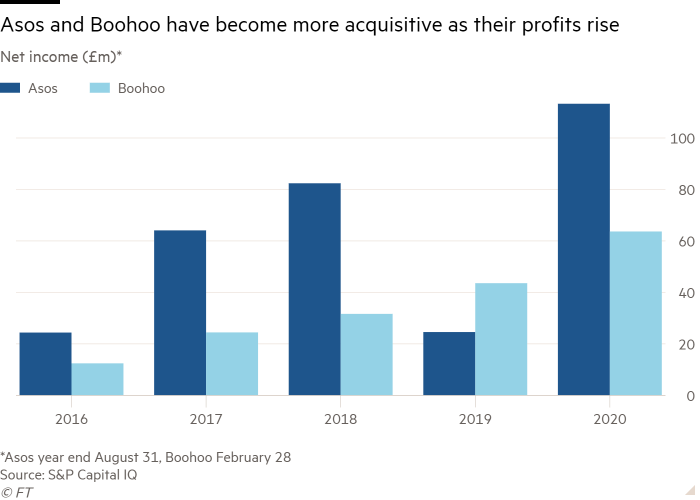
However, fast fashion is not without its problems. Consumers want their clothing increasingly cheaper and faster, but future global supply chain problems could hinder this. Additionally, fast fashion retailers are now confronting the environmental impact of the market. According to data from McKinsey, fast fashion is now responsible for about 4% of all global carbon dioxide emissions. By 2023, the emissions from textile production alone could increase by 60%.
When faced with the problems within fast fashion – both in terms of sustainability and supply chain optimisation – it’s clear that a solution is needed, and quickly. One viable retail solution is RFID, which could potentially transform the fast-fashion world. But why is RFID for fast fashion such promising technology?
Making Fashion Fast
As opposed to the historic seasons within fashion, fast fashion focuses on rapidly producing new styles at a rate of about 52 ‘micro-seasons’ per year. In 2019, the amount of clothing produced by global fashion brands totalled about 53 million tons, but this was expected to rise to about 160 million tons by 2050. Zara was one of the first brands to trial new bi-weekly deliveries of fashion inventory, and since then consumers have wanted clothes even quicker. Now, fast fashion brands are required to keep hundreds of pieces of stock on hand – either in-store or in distribution centres – to satisfy the constant need for products.

Fast fashion can also attribute its growth to the internet. Retailers with physical stores may see items go unsold – H&M had over $4 billion worth of unsold fashion inventory in 2018 and Primark were sitting on £1.5 billion of clothes in their warehouses. The flexibility of e-tailers, though, means that as long as they can get stock through the supply chain quickly enough, they can adapt to consumer trends. In comparison to brick-and-mortar fast-fashion retailers, brands like Boohoo often order only a select amount of stock, to see if it will sell.
This flexibility within the business model paid dividends when the Covid-19 pandemic hit. While clothing sales overall dropped by about 34% in the early months of the pandemic, internet retailers like Boohoo turned a profit. At the beginning of 2020, Asos predicted that they would make £30 million more than in a regular year due to the pandemic shift to online shopping.
The Problems with Fast Fashion
However, the rapid growth of the fast fashion industry has also exposed the flaws in this market. From supply chain crises to environmental impact, fast fashion has its downsides. Firstly, the industry relies on global supply chains, which is much riskier than keeping production closer to brick-and-mortar stores. Retailers had to confront this problem first-hand in 2021 when a trapped container ship in the Suez Canal caused an estimated loss of $9.6bn goods every day.
While not a direct result of the Suez Canal crisis, shipping costs have also risen dramatically over the last two years. Where a shipping container ship used to cost $1,500, it can now reach $15,000. Similarly, shipping times are also longer because of the pandemic, meaning it can take up to 8 months for stock to reach Europe from Asia. This is compared to about five weeks for production based in Eastern Europe. Consequently, many retailers are choosing to forego global supply chains and low-cost manufacturing processes in Asia and “nearshore” their production closer to home.
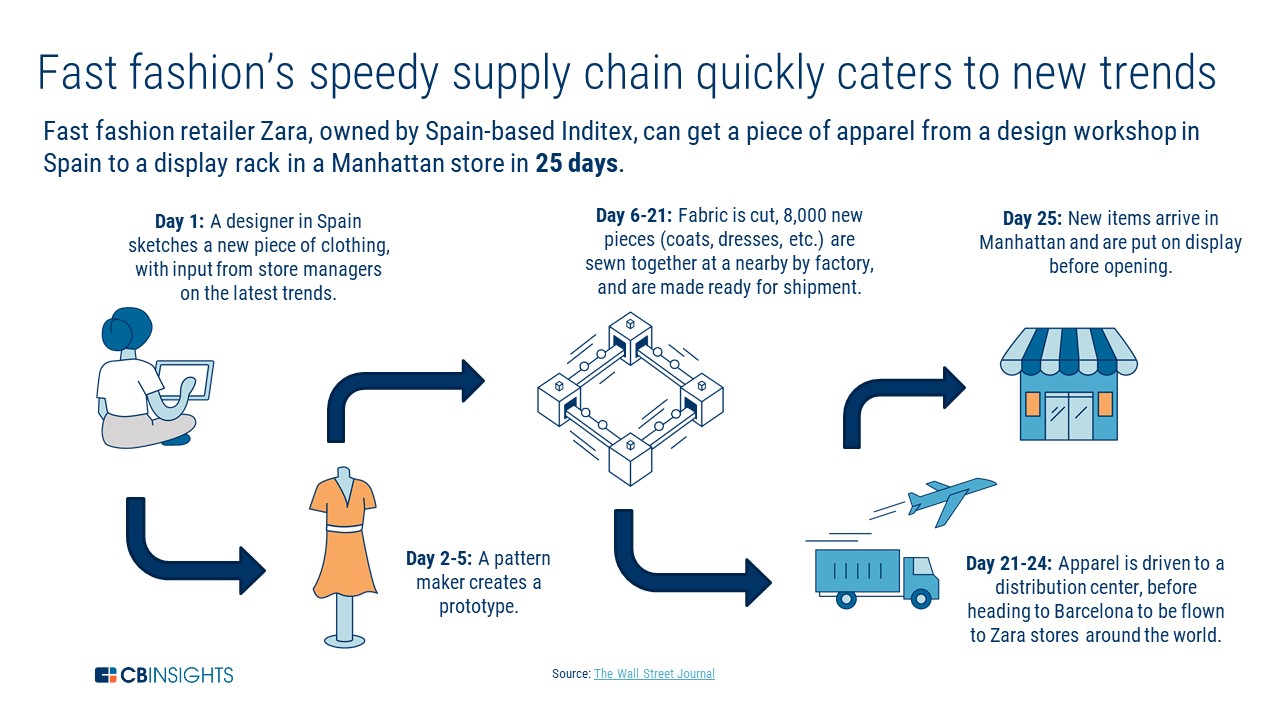
Aside from supply chain disruption, fast fashion’s biggest problem relates to its environmental impact. While the fashion industry as a whole has its sustainability issues (it can take 10,000 litres of water to produce 1kg of cotton, for example), fast fashion is particularly problematic. The quick turnaround of fashion inventory in the fast fashion industry means more waste and the increased use of raw materials.
In total, 84% of all discarded clothing ends up in landfill sites; and while 95% of textiles could be recycled, the fast fashion model doesn’t encourage recycling or reworking. What clothing does get donated to second-hand clothing stores or thrift shops has a similarly doomed life – the United States exports over one billion pounds of used clothing every year, most of which gets sent to used clothing markets in Sub-Saharan Africa. Due to the sheer quantity of products, fast fashion also doesn’t have the supply chain transparency to accurately track where products have come from and where they end up.
The Environmental Impact of Fast Fashion: Consumer Reactions
But do shoppers really care if the fast fashion industry is unsustainable? Well, the answer is both yes and no. In 2020, retailer Boohoo was investigated after it was hit with allegations of exploitation related to its factory in Leicester. According to reports, workers in the factory were being paid just £3.50 an hour to make clothing. However, consumer reactions to the news were lukewarm. Despite the company’s reputation taking a sharp hit in the months after the report was released, over half of Gen Zs said they would still buy clothing from Boohoo-owned fast-fashion retailers.
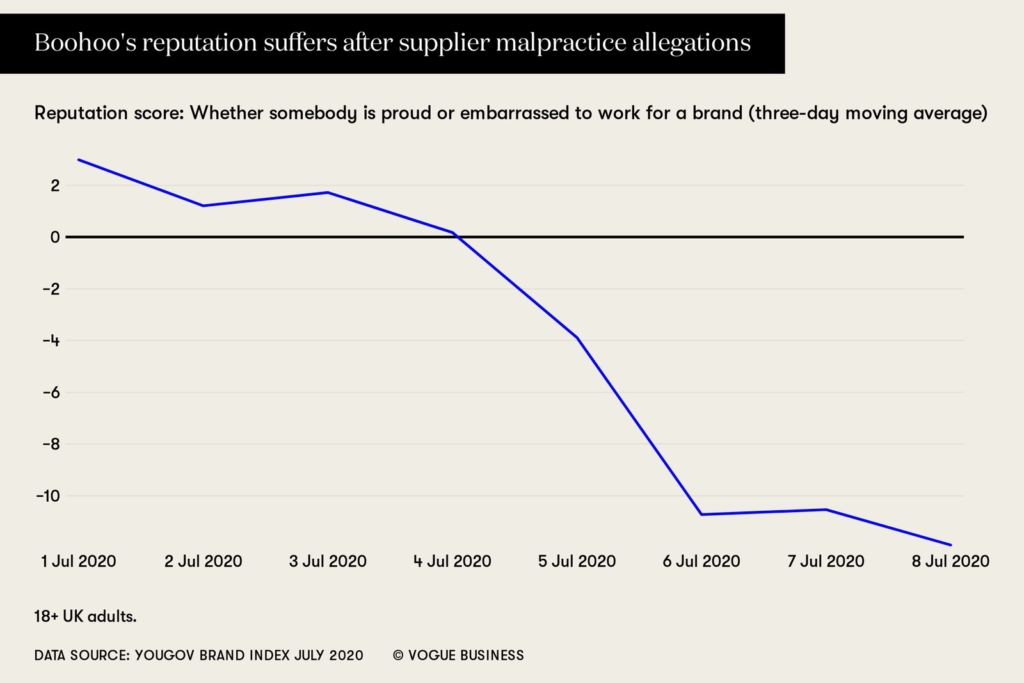
On the whole, though, consumers are reacting to news of unethical and unsustainable practices. A McKinsey report reveals that 1 in 3 consumers have stopped buying from particular brands because of sustainability concerns. 40% of respondents also said that they have actively started buying from clothing companies with a good sustainability record. However, there were still limits to how sustainably consumers can or want to be. 46% of people said that additional information about the origin or sourcing of products would help them to be more sustainable, and 50% wanted more recycling options for used products.
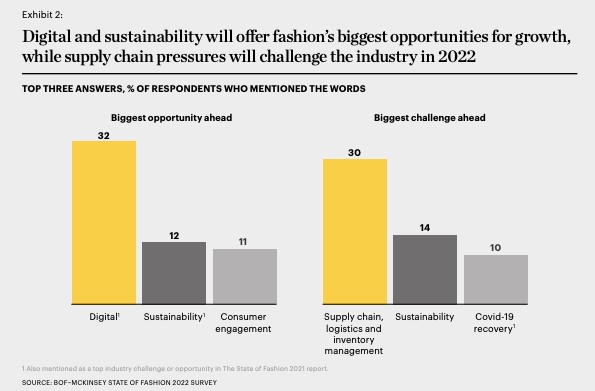
15% of fashion industry executives say that sustainability is one of the top challenges for them in 2022. However, supply chain logistics are perceived as an even bigger threat to the industry, with 30% of respondents citing fashion inventory management or logistics as one of their top three concerns. Any future fast fashion retail solution will have to address the combined issues of supply chain disruption and sustainability – and implementing RFID in fast fashion could achieve this.
The Benefits of RFID for Fast Fashion
So, what’s the retail solution for fast fashion’s problems? Well, fast fashion retailers could turn to RFID to tackle both sustainability issues and problems in their supply chain. RFID in fast fashion is nothing new – Zara has already invested in digital tags in their supply chain network and full integration of RFID across their network was completed in 2020. However, the technology is rapidly decreasing in cost, meaning there’s a huge potential payoff for retailers who invest in fast fashion RFID technology today.
Transparency
If fast fashion retailers are to prove that their products are from entirely sustainable sources, they will have to embrace transparency in their operations. Consumers now want to know where their products come from, and whether they can trust sustainable labels on clothing.
For fast fashion, RFID can be the retail solution to transparency. Only with accurate data and information about supply chains can retailers provide honest and open updates about their fashion inventory and ethics.
Fashion inventory visibility
Real-time visibility is important for any retailer, but even more so in the fast fashion industry. Only when you can track stock in real-time can you adapt to shortages and delays. RFID in fast fashion offers a way to accurately track stock through the supply chain, allowing retailers to make more accurate decisions and identify problems.
When fashion inventory is tagged at the point of production, its journey can be traced throughout the supply chain to a high degree of accuracy. It’s also possible to scan large amounts of stock at once, making the process straightforward and offering instantaneous data. RFID can also make supply chains more resilient by revealing weak points in operations. As a result, decisions affecting the supply chain can be made more quickly and with accurate data to back them up.
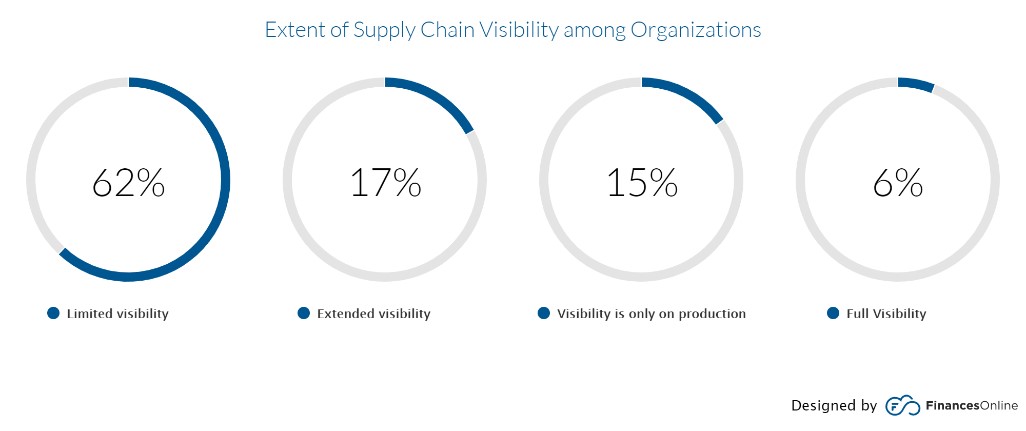
Returns
We know that consumers are asking for options regarding recycling initiatives and returns policies in order to make their clothing consumption more ethical. With customers increasingly turning to online ordering, the returns process has become more complex for stores, as they need to offer options to post from home or return to store. RFID in fast fashion solves this problem, letting retailers know exactly where a product is at all times.
RFID is also a way for retailers to embrace sustainable options like fashion rental. When RFID tags are implemented on all fashion inventory, it’s easy to implement returns and even categorise clothes for washing after they’ve been returned.
Sustainability
RFID in fast fashion can also boost a retailer’s overall sustainability by improving the accuracy of stock takes. Knowing exactly which items are selling and which aren’t means that retailers can adapt quickly to consumer demand, and only order what will sell. There is a huge problem with inventory loss in the fashion world, but this can be solved with accurate data. With RFID, fast-fashion retailers can only order the inventory they need and be assured that they won’t run into out of stock notices because of the technology’s accuracy.
The Future of RFID in Fast Fashion
There’s no doubt that, despite its drawbacks, fast fashion will continue to be popular, especially among younger generations who often are blind to the environmental impact of the fashion market. Many fast fashion brands are already making changes to their business models in reaction to issues like sustainability. Inditex, which owns Zara, Bershka, and Pull&Bear, has said that 100% of their cotton, linen, and polyester will be from sustainable sources by 2025. H&M is vowing to improve the percentage of sustainable or recycled materials they use from 57% to 100% by 2030.
While these initiatives will undoubtedly make brands more sustainable, they are also complex and high-cost. If brands are looking for a low-cost, high-return way to boost their ethics and improve their reputation, RFID in fast fashion is an ideal retail solution.

A fast fashion RFID solution
Stock accuracy, on-floor availability, and omnichannel applications in stores.
Book a demo with Detego to find out how our cloud-hosted RFID retail solution could help you optimise your approach to fast fashion inventory. Our multi-user app can provide intelligent stock takes and a smart in-store replenishment process and later, you can scale the solution to offer omnichannel services and effectively manage your entire store operations with real-time, item-level inventory visibility and analytics.
The past two years have been undeniably difficult for retailers. From reduced footfall in physical stores to grappling with staff shortages, there have been few advantages, and many long-term effects, to the recent disruption. The same is true for supply chain issues that have beleaguered retailers over recent years. Businesses have had to adapt to problems including shipping delays, higher delivery costs, and fluctuating consumer demands, and though we’re seeing the first signs of economic recovery, these issues won’t disappear overnight. Some analysts have predicted that it could take until mid-2024 for supply chains to return to relative normal.
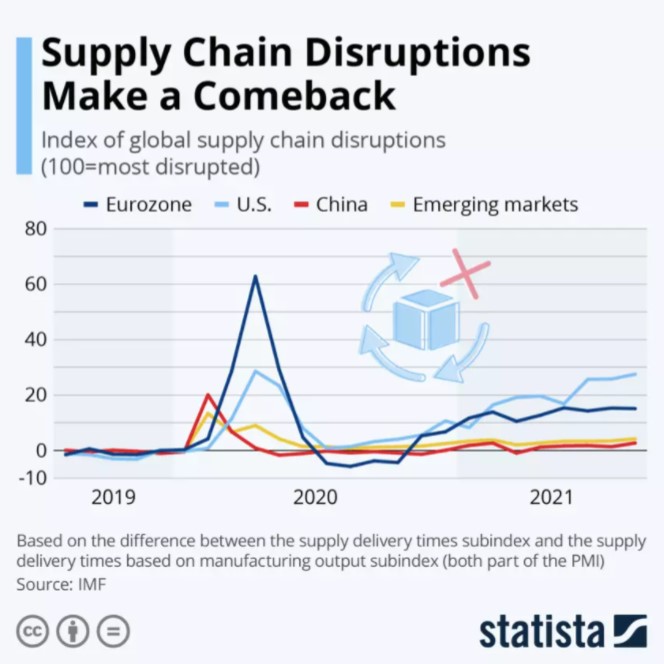
So far, retailers have been forced to react to supply chain disruption as it happens, flexibly accommodating their business operations to the issues. However, there are ways for retailers to turn supply chain issues to their advantage, and the solution involves retail inventory management software.
Most businesses will already have some form of retail inventory management process; it’s a crucial part of omnichannel retailing, for example. But technology like RFID combined with powerful inventory software can offer a way for retailers to not only adapt to supply chain disruption but conquer it.
The Current Supply Chain Issues
The fallout from the Covid-19 pandemic is still being felt in global supply chains. While retailers have weathered the worst of the storm with regard to inventory delays, there are still challenges in the global supply chain that will inevitably take time to remedy. In fact, 94% of Fortune 1000 companies are still experiencing supply chain disruptions as a result of the pandemic.
One of these major challenges is the cost of shipping. Global shipping costs spiralled in 2021, reaching a peak in the latter half of the year. In October, the average cost of shipping a standard 40ft container reached $10,000. Costs have since declined by 16%, but are still higher than in normal years – in some cases by more than four times the average. In 2019, the cost of shipping a container from Shanghai to New York was $2,500, but this has since risen to $15,000.
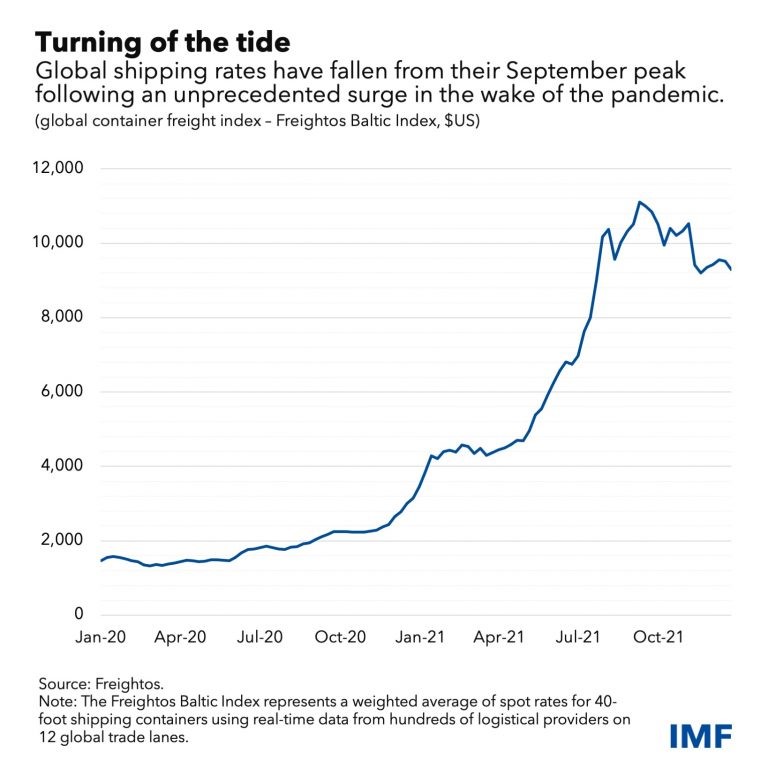
As well as increased costs to ship inventory from manufacturer to store, retailers also have to adapt to delays in shipping. The global supply chain is still adapting to Covid-19 setbacks, resulting in persistent delivery delays. At present, there are 20 million containers waiting at ports all over the world, and this backlog will take more than a few months to resolve. While the scale of the issue doesn’t compare to early 2021 – when supply chain delays and shortages were up 638% – many businesses will still be experiencing shortages or delays well into 2022.
Finally, there has been a shift towards more environmentally-friendly practices in a wide variety of industries. Companies are also looking at ways to make their supply chains and logistics more sustainable. This includes switching to more sustainable shipping options like biofuel instead of diesel, eco-driving, or moving operations closer to customers. However, a move towards sustainable operations is challenging and requires coordinating entire supply chain operations and more complex retail inventory management.
Outperforming During Disruptions
Despite ongoing supply chain troubles, some retailers have done more than just endure the issues – they have thrived on the disruption. Brands like Walmart, M&S, and Pets at Home have all posted strong growth over 2021, despite grappling with intense supply chain disruption. The one thing these brands have in common? Omnichannel retail.
Over the last two years, consumers have switched from in-store shopping to online shopping. There was a pronounced switch to online retailing in 2020, which then persisted throughout 2021. In the UK, online sales made up 30% of overall retail spending in 2021. While still less than a third of overall spending, this is a jump from the 11% of sales that were conducted online in 2019.
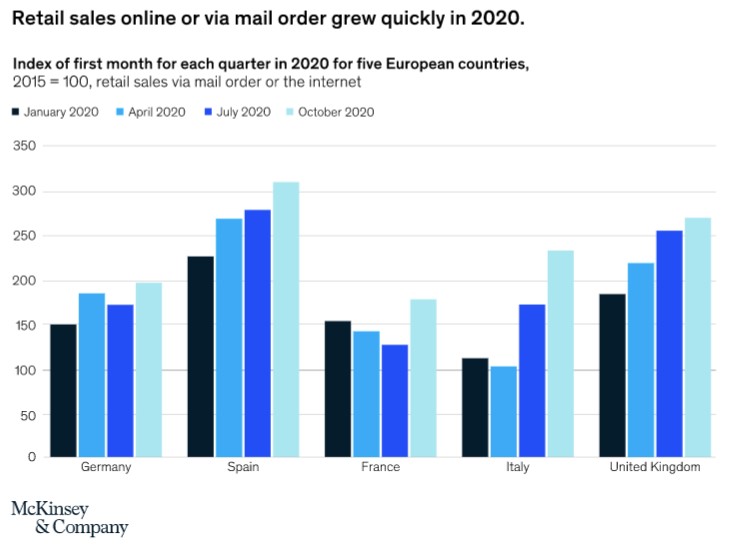
However, for many retailers, it wasn’t simply a question of turning attention to online sales. Instead, an omnichannel solution that combined in-store shopping and online options proved the most effective option. Nike, for example, continued with plans to open a flagship store in Paris during the pandemic. Instead of floundering as footfall in brick-and-mortar stores fell, they found that the physical store also helped drive online sales. Retailers who open a new physical location can see a 37% increase in traffic to their website in the following quarter.
For some companies, it was a question of evaluating their supply chains and seeing where they could improve. Sports brand SylvanSport ran into issues when their overseas tire manufacturer couldn’t deliver on time, so they had to look at alternatives. This included seeking domestic manufacturers to create the product for them while still retaining their overseas manufacturer for future orders. This flexibility within their supply chain allowed them to easily adapt to any issues as well as future-proof their operations in case of further disruption.
How to Adapt to Disruption
It’s clear that supply chain challenges aren’t going away anytime soon. Consequently, retailers must plan for periods of disruption and find a way to come out of them performing stronger. For a start, we know that retailers who have outperformed during the last two years have focused on a few things: omnichannel solutions, consumer trends, and real-time data.
Data is a powerful tool when it comes to adapting to supply chain disruption, but many retailers aren’t taking advantage. In fact, 54% of company executives have said they don’t have clear visibility of their supply chain past Tier 1, and an additional 40% of companies don’t have accurate end-to-end visibility and reporting. This means that any disruption in the early stages of their operations will go unseen, and the consequences felt only when it’s too late.
However, companies are learning that technology like retail inventory management software is a powerful way to improve their operations – 89% of retail organisations said they will need to implement data management software in their supply chain.
Companies that do turn to AI-powered data solutions inevitably become more resilient. Having a clear understanding of supply chains, and their weaknesses in them can make companies more able to adapt to difficulty when it arises. When Japan was hit by a magnitude-9 earthquake in 2011, production at Toyota’s factories ceased for two months. After this, they focused on building an accurate database of their suppliers and parts to track their operations and products through the supply chain. In 2016 and 2019, when more earthquakes hit Japan, Toyota had reduced their production stoppages to just two weeks.
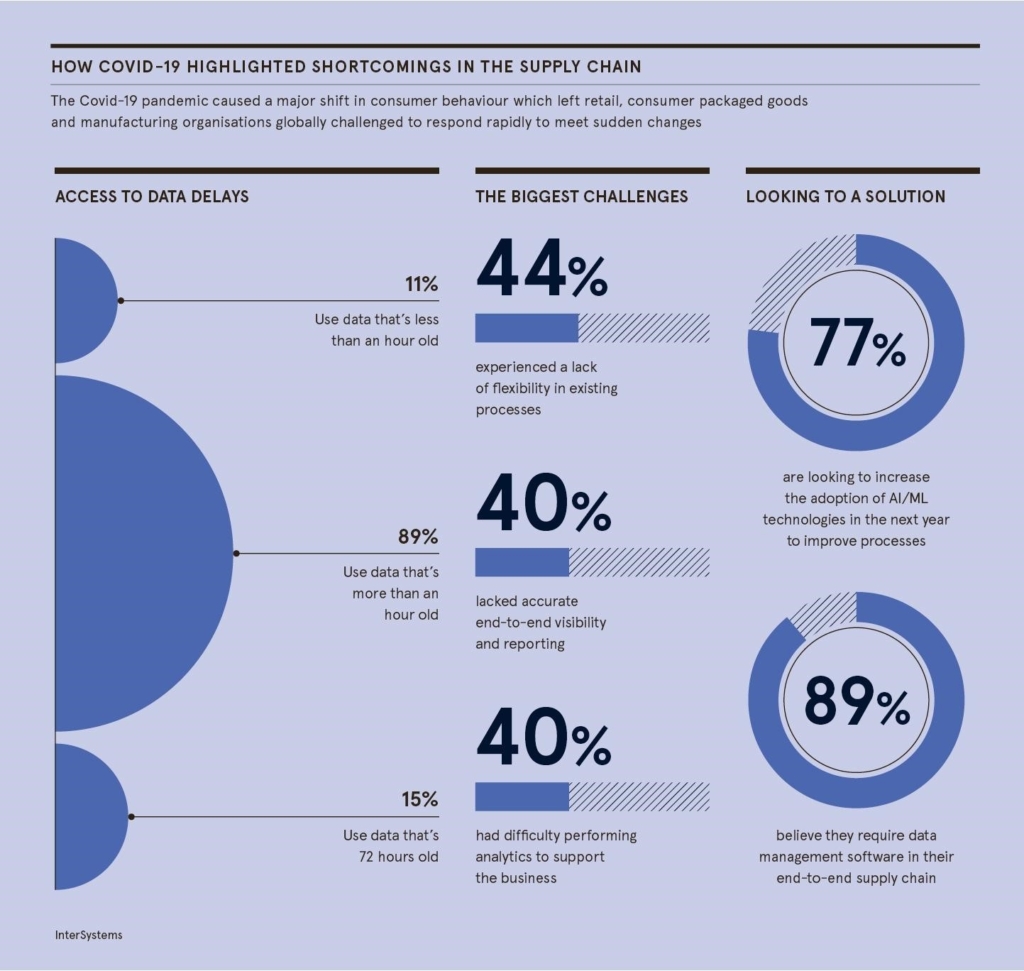
We also know that omnichannel services are the way forward for modern retailers. Consumers are asking for alternative ways of purchasing products, and omnichannel retailing also paves the way for future technology like AI-powered brick-and-mortar stores and virtual shoppers.
Since the beginning of the pandemic, one-third of American shoppers have taken advantage of omnichannel services including deliver-to-store, and two-thirds of those shoppers plan to continue taking advantage of omnichannel retailing in the future. As the previous example from Nike demonstrates, it’s not about turning 100% to online services, but about offering multiple opportunities for consumers to purchase products.
According to a study from McKinsey, brick-and-mortar retailers – though at a disadvantage over the last two years due to a decrease in footfall – still have to spend comparatively less on advertising in order to reach the same amount of customers as online retailers. So, it’s about developing an approach to omnichannel that blends online and physical retailing, allowing customers to purchase exactly when and how they want.
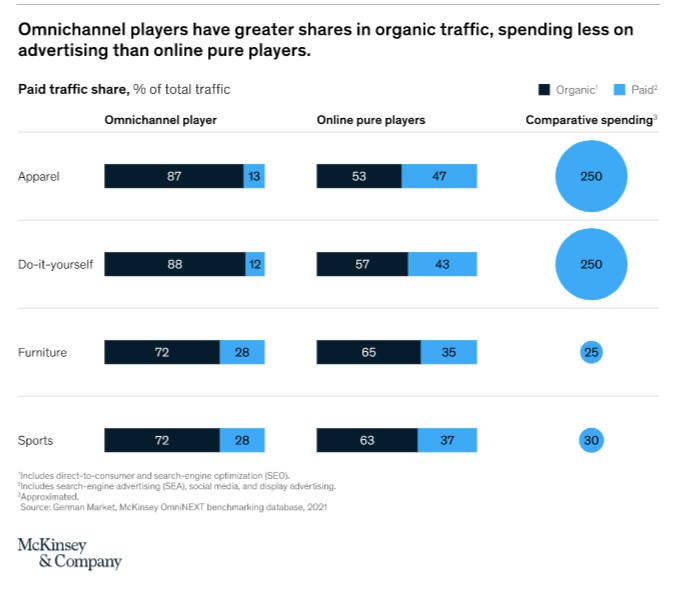
The final way retailers can increase the resilience of their operations and their supply chains is by paying close attention to changes in consumer behaviour. Arguably the biggest consumer trend for 2022 is a shift towards sustainability. In 2021, one in three consumers stopped buying certain brands because of sustainability or ethical concerns, and 46% of consumers wanted additional information over the origin of their products. To retain consumers in the coming years, it’s crucial that brands consider the environmental impact of their supply chains and make the necessary changes before customers choose alternative products.
The Benefits of Retail Inventory Management Software
We’ve identified three ways to turn supply chain disruption to your advantage: developing an omnichannel strategy, harnessing the power of digital insights, and staying aware of consumer trends. For all of these strategies, it’s crucial that companies dedicate some time to reviewing their retail inventory management system. Without a successful system in place to track and count inventory, you won’t be able to implement omnichannel services or make changes to your supply chain in reaction to consumer trends.
In order to accurately track inventory and respond to supply chain disruption, companies should consider investing in retail inventory management software. An all-in-one retail inventory management software, with the help of RFID tags in your supply chain, can provide businesses with real-time insights and inventory flexibility to increase supply chain resilience.
Real-Time Insights
An all-in-one retail inventory management software offers retailers real-time insights that can transform operations. While digitising your entire supply chain might seem like a mammoth task, RFID supply chain technology is becoming more accessible and easy to implement.
In particular, the ability to monitor supply chains at all times, and receive real-time data from supply chains, makes it easier to make operations decisions fast. When the container ship, the Ever Given blocked the Suez Canal last year, 15% of the world’s freight was impacted. Implementing solutions quickly became of the utmost importance – only companies who had immediate insights into the effect of the crisis on their operations could make decisions to avert supply chain disasters.
Retailers that had already implemented a retail inventory management solution could immediately make decisions to shock-proof their operations from the disaster and recover more quickly.
Supply Chain Visibility
In order to adapt to disruption, it’s important that businesses have a clear, end-to-end view of their operations. However, many businesses currently don’t have the level of supply chain visibility necessary to quickly adapt to disruption. Retail inventory management software, when paired with RFID tags in the supply chain, can give businesses the visibility they require to outperform.
Only with a clear view of the supply chain from manufacturer to store can businesses accurately see where their stock is and react to shipping errors or delays. This is even more crucial as businesses turn to omnichannel experiences to boost sales, where it’s crucial to see where stock is and ensure that other services like ship-to-store or store pick-up can happen successfully.
Not only does retail inventory management software offer businesses end-to-end insights into their operations, but it can also help with sustainability efforts by enabling operations to be fully transparent to consumers.

More Accurate Inventory Counts
Implementing RFID in your supply chain can also make it easier to get accurate inventory counts. When there’s a disruption to inventory deliveries, knowing exactly what stock you have can make a big difference to your sales and allow store changes to be made swiftly. When used alongside a retail inventory management platform, RFID tags can help achieve 99% stock accuracy.
RFID technology enables retailers to quickly see which stock may incur delays and prepare for potential out of stock notices. For example, Reiss increased their sales by 4% by increasing their stock accuracy as they had an accurate view of exactly what stock was available and where. This makes it easier to implement omnichannel strategies like buy-online-pick-up-in-store (BOPIS). With accurate stock counts, it’s also easier for retailers to quickly adapt to consumer trends, focusing their attention on only the stock that is selling well.

Retail inventory management solution
Stock accuracy, on-floor availability, and omnichannel applications in stores.
Book a demo with Detego to find out how our cloud-hosted retail inventory management solution could help you outperform competitors and adapt to supply chain disruption. Our multi-user app can provide intelligent stock takes and a smart in-store replenishment process and later, you can scale the solution to offer omnichannel services and effectively manage your entire store operations with real-time, item-level inventory visibility and analytics.
NFTs, or non-fungible tokens, are the current talk of the art world. Though they’ve existed since 2014, the popularity of NFTs rose rapidly in 2021, with trading hitting $10.7 billion in the third quarter of that year.
NFTs can be anything – art, memes, and even newspaper articles or tweets. They are stored on a blockchain, the database that cryptocurrency relies on. However, unlike crypto, NFTs cannot be exchanged with another digital asset – each NFT is entirely unique. Each NFT that is sold has no equivalent, and blockchain technology is used to establish sole ownership and digital provenance. These digital assets can be resold on specialised online marketplaces, making them a lucrative investment opportunity. In the world of NFTs, anything can be monetised and sold, which is also part of their appeal.
Their popularity can be explained by the fact that they are simultaneously exclusive and are becoming more affordable. Individual NFTs are highly unique but theoretically anyone with an internet connection – and enough capital – can access the world of collective NFTs.
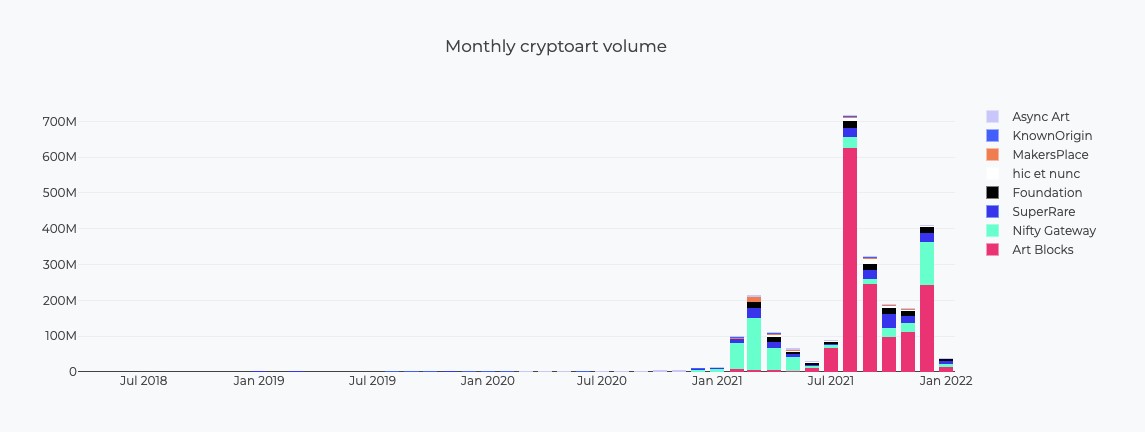
More recently, the world of retail is seeing value in NFTs. While some NFT sales have made headlines for their expense, the majority of NFT purchases in the first 10 months of 2021 were valued at less than $10,000. This means they can be categorised as ‘retail’ in nature. In the second half of 2021, brands including Adidas and BoohooMAN created their own NFT collections, hoping that they could capitalise on the technology’s popularity. High fashion brands are also trying their hand at NFT collections, including Dolce & Gabbana.
Is there a future in NFTs for retailers? That depends in part on your brand and target market. According to a survey from Morning Report, 15% of male respondents said they collected NFTs, compared to only 4% of female respondents. For high fashion brands, who more often than not have a female consumer base, NFTs can be a way of driving sales from male consumers. Alternatively, if your brand already markets predominantly to men, NFTs are a lucrative way of increasing revenue.
Based on the growth of NFTs in the latter half of 2021, it’s clear that NFTs will continue to increase in popularity. The most expensive NFT in 2021 was sold for $69.3 million in March, and while NFTs for retailers are unlikely to market for the same extraordinary prices, it’s evidence of the profit that can be created with NFTs. The entire NFT market is expected to grow to $240 billion by 2030, and NFTs for retailers could offer brands a lucrative opportunity to enter the burgeoning digital asset market.
A New Market in NFTs for Retailers
The NFT market has grown from a niche area for technology and crypto enthusiasts to something more accessible to the average consumer. At the same time, over the course of 2021, the average transaction size and the total value of NFTs increased. By October 2021, collector-sized transactions of between $10,000 and $100,000 accounted for 19% of all NFT transactions, compared to 6% in March 2021. This suggests that NFT assets are gaining value rapidly and that collectors and consumers aren’t put off by high price tags.
Despite the growth in large NFT transactions, the majority of purchases are still conducted at retail level – that is, with transactions of less than $10,000. In comparison to the crypto market, NFT purchases are still driven by retail purchases, not collectors or larger institutional transactions of over $100,000. In 2021, 80% of NFT purchases were made by retail buyers, despite the growth in those high-value collectors and institutional transactions. For this reason, the market for NFTs for retailers is promising – it could prove to be a major retail innovation in the next five to ten years.
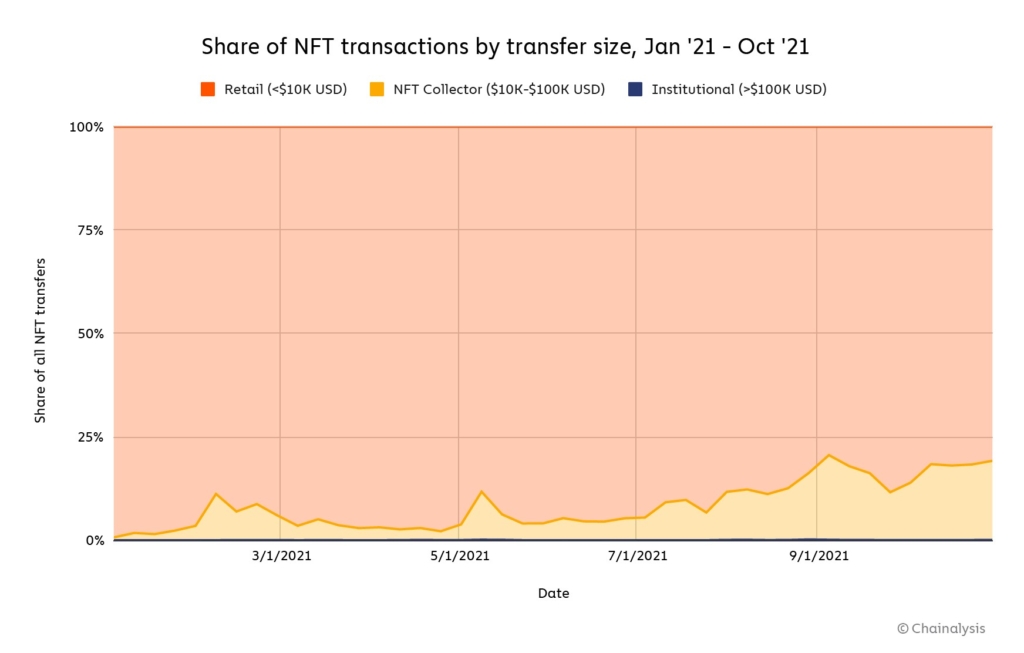
Additionally, the audience for NFTs for retailers is already there. Millennials are the most likely generation to engage in NFT purchasing, with 42% of millennial respondents to one survey saying they do collect NFTs. They are followed by Generation Xers, of whom 37% say they are collectors.
Despite Generation Z occupying a strong part of the retail market, they are one of the generations least likely to be involved in NFT collecting or retail purchasing, beaten only by baby boomers. Just 4% of Gen Zers said they collect NFTs, because of limited purchasing power or a lack of interest in collecting digital assets as a hobby. Despite Gen Z’s current reluctance to get involved in NFT purchasing, there is interest there. One study found that despite such a small proportion of Gen Zs currently purchasing NFTs, close to 30% say they are interested in purchasing in the future. Of those who said they were uninterested, 57% claimed the reason was because of a lack of understanding. As blockchain and crypto become more mainstream technologies, understanding will inevitably grow, making Gen Z another promising market for retailers involved in the technology.
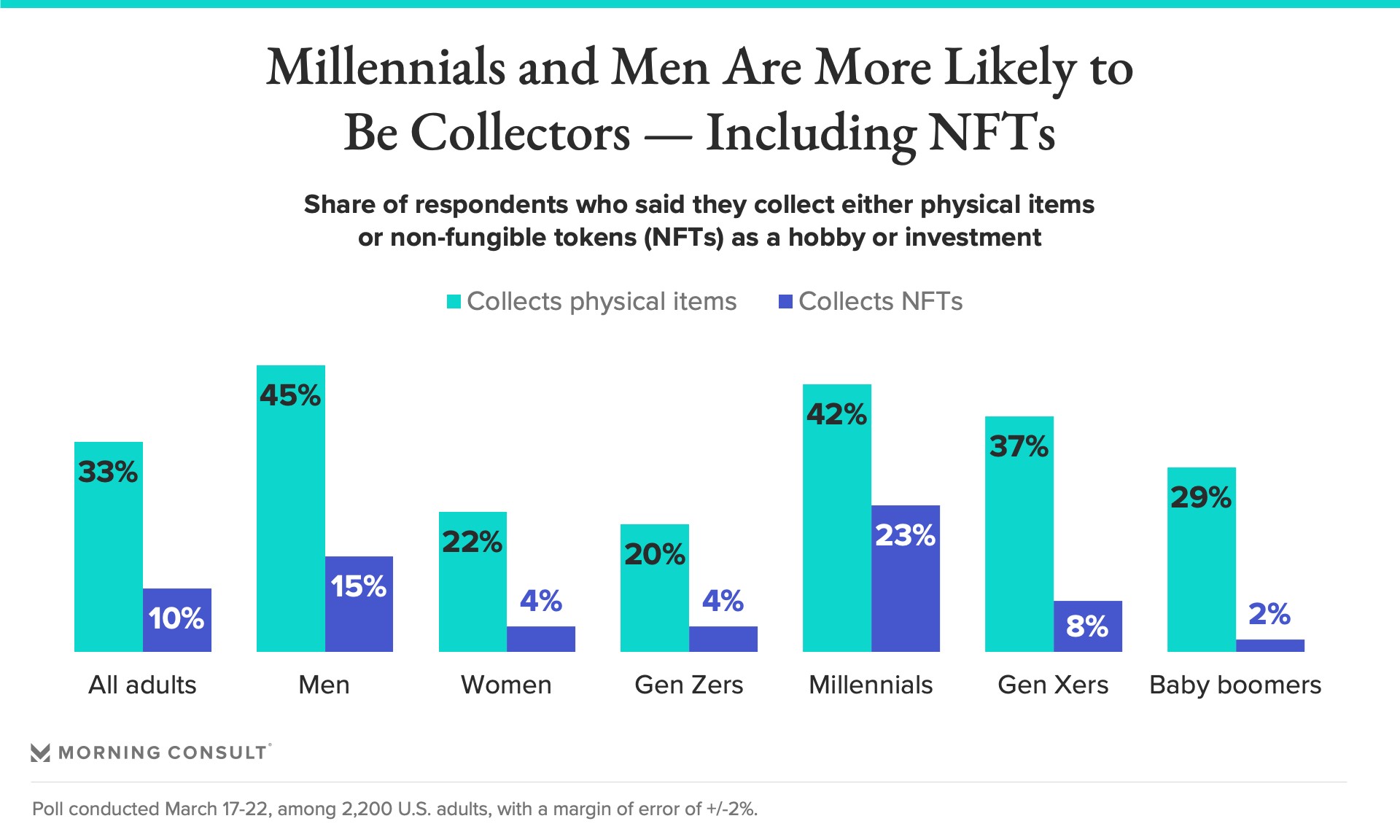
Retailers are Already Taking Advantage of NFTs
The first instance of a fashion brand embracing NFTs for retailers was when fashion house The Fabricant sold a digital dress for £7,500 in 2019. Since then, more retailers have turned to NFTs to expand their brand awareness or explore a new avenue of profit. According to the Vogue Business Index, 17% of fashion brands have already worked with NFTs.
Last year, Adidas took their first foray into the world of digital art. Their debut collection Into the Metaverse consisted of 30,000 NFTs, each of which gives the buyer exclusive access to physical merchandise that will become available in the future. The NFTs sold out within hours and Adidas earned approximately $22 million in sales. The retailer has since stated their intention to bring out more NFTs in the future, and with the success of their first collection, future profit is almost guaranteed.
They’re not the only brand to consider NFTs for retailers the future of retail. In late 2021, BoohooMAN became one of the first major fast-fashion retailers to branch out into NFTs. However, unlike Adidas, BoohooMAN is planning on giving their NFTs away for free to eight lucky winners. This fundamental change – from NFTs as a revenue stream to a marketing tactic – is evidence that BoohooMAN sees more than just monetary value in digital assets.
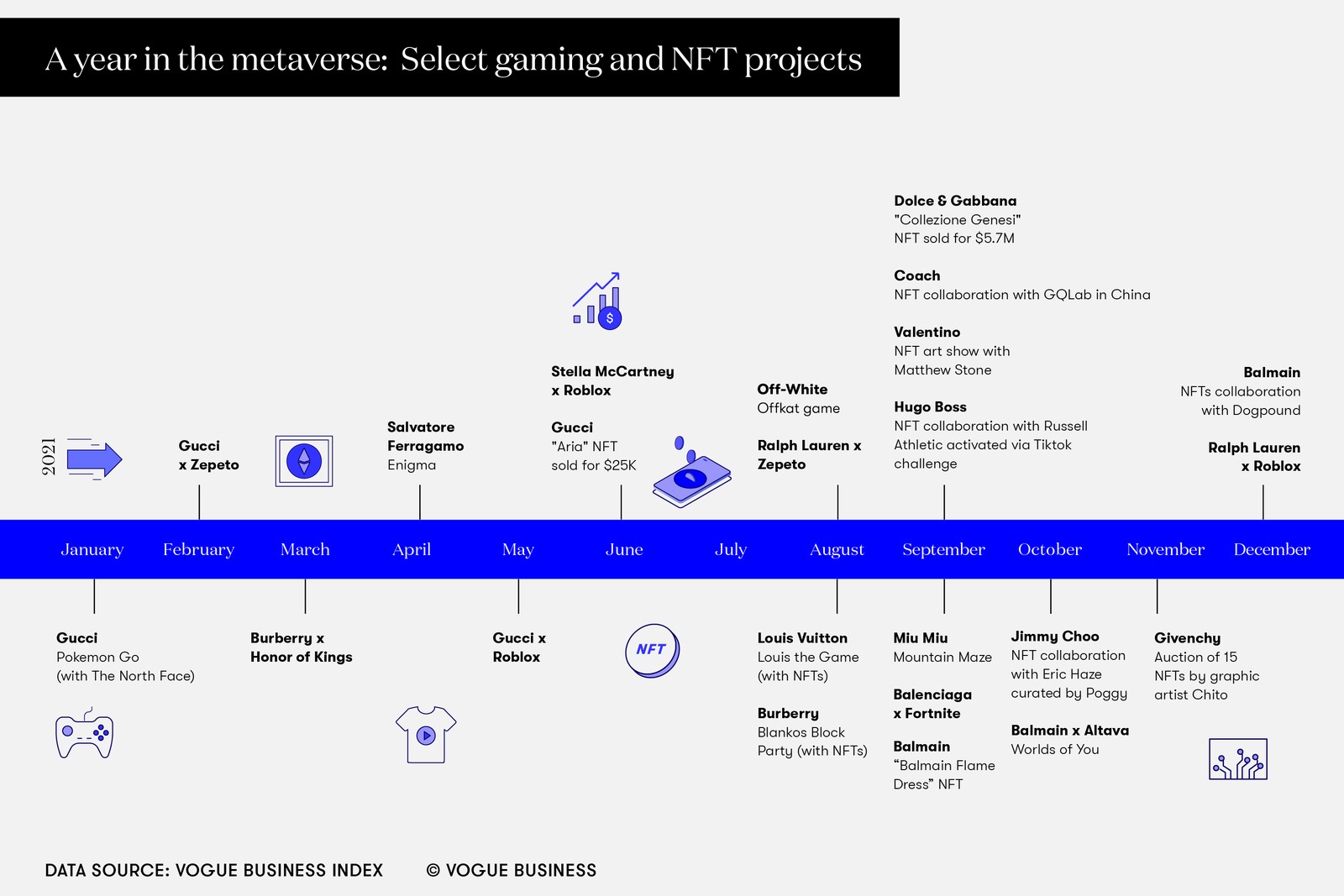
Retailers and the Metaverse
Here lies another advantage to engaging in NFTs – increasing brand recognition. At the end of last year, we explored why brand consistency is so important for retailers. With the rapid increase in omnichannel retailing, it’s more important than ever that retailers ensure consistent brand identity across all channels. As another marketing channel, NFTs for retailers can be a powerful way to increase brand awareness and add another facet to your brand identity. This is especially true as we start to see digital spaces like the metaverse becoming more common.
The metaverse is destined to be a 3D version of the internet where users can interact in real-time with others in a realistic virtual space. There are numerous applications for retailers here, including virtual stores where users can shop for virtual goods like NFTs using cryptocurrency. The brand opportunities present in NFTs for retailers are staggering – with so many people potentially entering the metaverse with avatars, there’s a chance for retailers to sell their products and gain much larger visibility across the globe. Despite being a relatively new retail innovation, the metaverse promises to change how customers shop and could be a key part of the future of retail.
Retailer ASICS has already taken one step towards the metaverse, with plans to develop a digital store where consumers can interact with the brand’s products. Luxury retailers are also exploring the possibilities the metaverse can offer. Last year, Burberry launched an online game that users can access by purchasing an NFT. In the game, they can interact with the brand’s identity and products, and purchase virtual accessories like jetpacks, armbands, and pool shoes. With retailers already considering ways to become digital-first, the metaverse offers opportunities for building brand identity, and revenue, outside of physical stores, and NFTs for retailers is a huge part of this.
Are NFTs The Future of Retail?
McKinsey’s State of Fashion 2022 report concluded that NFTs are likely to become part of the mainstream for retailers this year. With the rapid growth of the market and the branding and profit opportunities afforded by the sale of digital assets, it’s clear they will become a staple in the future of retail. In fact, the luxury NFT market is expected to grow to $56 billion by 2030, and while luxury NFTs will still comprise a small proportion of the overall market, this retail innovation will see increased demand because of the metaverse.
When considering if NFTs for retailers represent the future of retail, it’s also worth considering the as-yet undeveloped applications of the technology. Retailers may find that embracing the technology now could offer unforeseen advantages in the future as blockchain and NFTs for retailers become more widespread. As the technology becomes more accessible, it will also be easier for brands to explore opportunities within NFTs.
Though the market for NFTs for retailers is likely to grow, retailers should be aware of the potential implications of embracing NFTs. We already know that the retail industry is committed to becoming more sustainable. 14% of respondents to McKinsey’s State of Fashion 2022 said that sustainability would prove the biggest challenge for the fashion industry, while 12% regarded sustainability as an opportunity. NFTs, though, present a major sustainability problem.
NFTs rely on the cryptocurrency Ethereum, which in turn relies on huge amounts of electricity to keep transactions going. To establish digital provenance and security in the blockchain, “miners” solve cryptography problems with high-power computers. In doing so, they draw a huge amount of power from the grid – Ethereum’s total annual carbon footprint is estimated to be the same as that of Hungary. The future of retail may well lie in the metaverse and NFTs. However, brands will have to think carefully about whether embracing NFTs for retailers may contradict their sustainability goals and negatively impact their brand reputation.
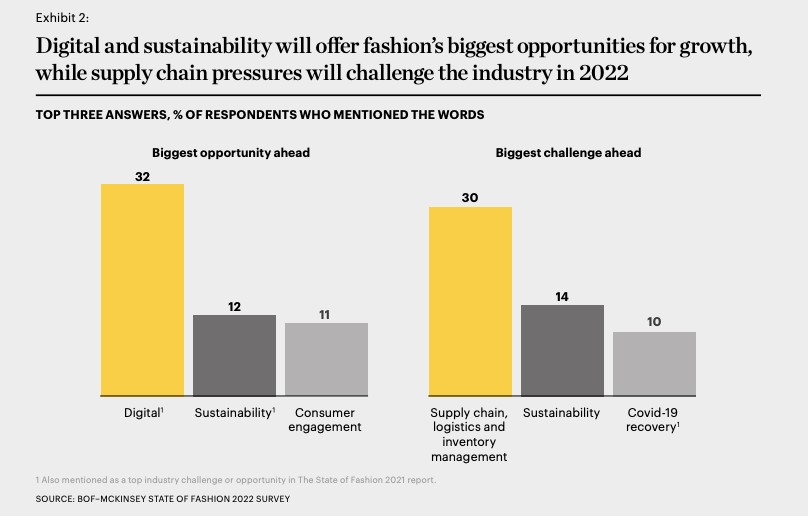
NFTs for Retailers and RFID
Beyond investing in collectible NFTs, an additional advantage of blockchain technology that often goes under the radar is that retailers can use it to establish product authenticity. Globally, the counterfeiting industry is valued at $500 billion a year, with luxury retailers particularly vulnerable. In the future, NFTs for retailers might be used to establish product authenticity and supply chain transparency, combating common problems in the retail industry like counterfeiting.
Existing technology like RFID can be harnessed alongside blockchain to provide customers with additional information about their products. “Product passports” will support authentication by offering information about products and their provenance through virtual tags. Chanel are already utilising this technology, replacing physical tags in their luxury handbags with a digital passport through a scannable metal plate.
With the global adoption of RFID technology on the rise, it’s likely that we’ll see more collaborations with RFID and NFTs for retailers in the future. Whether NFTs will become a mainstay in the future of retail remains to be seen, as many consumers are still in the dark about the technology. However, there’s no doubt that it’s a retail innovation that offers opportunities for increased revenue, brand visibility, and security.

Cloud-hosted RFID software
Stock accuracy, on-floor availability, and omnichannel applications in stores.
Explore how Detego’s all-in-one cloud-hosted RFID retail innovation could help you increase revenue. Our user-friendly software enables you to keep accurate stock counts, improving the efficiency of your omnichannel services and boosting revenue. Click the link below to book a demo.
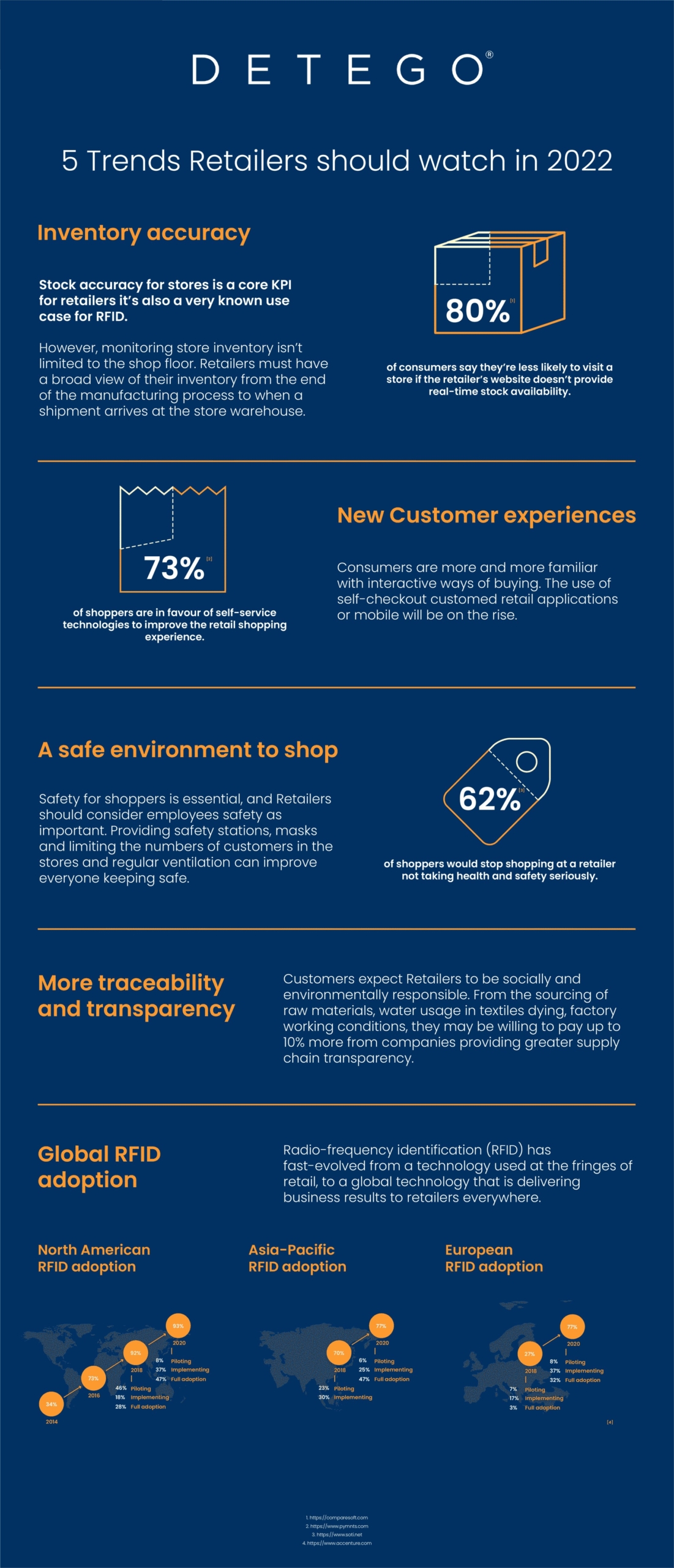
It’s no secret that omnichannel retailing is increasing rapidly. Retailers now understand that to achieve maximum sales and growth, it’s no longer possible just to have a brick-and-mortar store. Instead, retailers must utilise multiple sales methods to reach the maximum number of customers and provide a variety of ways to purchase.
The payoff for retailers who have invested in omnichannel services is massive. US retail giant Target saw its digital sales increase by 195% in 2021. In addition to this, they discovered that omnichannel customers spend four times the amount store-only customers spend and ten times more than digital-only customers. For example, 80% of customers who return products to stores choose to spend their refund in store. The growth possibilities for retailers who embrace omnichannel services are endless.
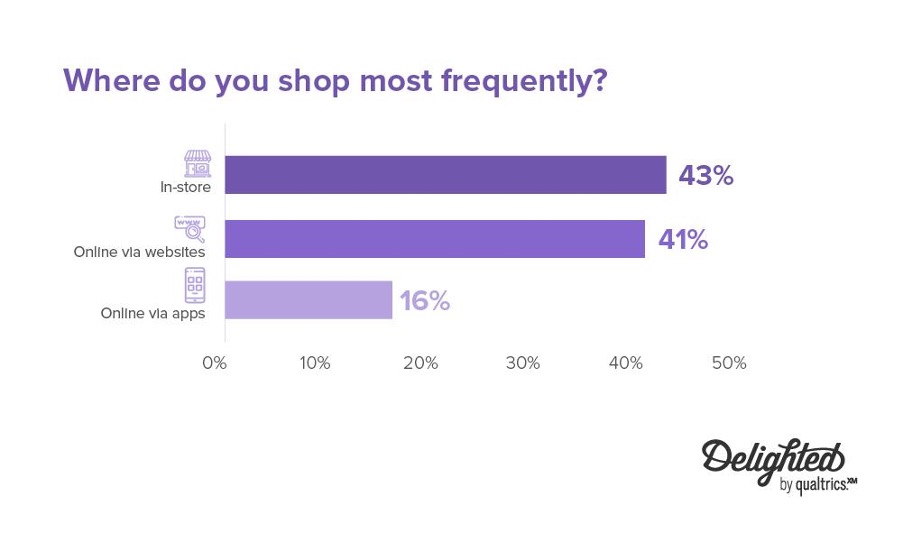
However, a critical feature of successful omnichannel retailing that often goes under the radar is brand consistency for retailers. This means improving your brand assets alongside your physical retail assets – for example, investing in your social media – and keeping a consistent brand identity across all of your digital platforms and in-store.
Retailers that prioritise brand consistency notably fare far better than those with a lukewarm approach to branding and identity. For example, luxury fashion house Louis Vuitton has managed to sustain their brand identity over a 160-year history, repurposing this into an online brand with over 20 million followers on Instagram. Similarly, fashion retailer Boohoo has thrived over the last year as it has built a consistent image across its app, social media accounts, and website.
Brand consistency for retailers has undoubtedly become more important as e-commerce has become a mainstay of the retail environment. Analysis from Millward Brown Optimor found that in 1980, most of the value of an average S&P 500 company came from physical assets such as factories or inventory. However, in 2010, these physical assets comprised a maximum of 40% of the company’s total value. The other 60% of the company’s value came from intangible assets, and around half of it was attributed to the brand.
We know that omnichannel retailing will only grow in the future, as will the dependence on e-commerce. In 2021, the percentage of customers who shop online (41%) is catching up with the percentage of customers who still shop in physical stores (43%). As a result, brand consistency for retailers will also become a top priority.
How Retailers Can Successfully Achieve Brand Consistency
There are several factors to achieving brand consistency for retailers. Cultivating a consistent brand identity is also more challenging for retailers than in other industries. Companies need to consider their in-store layout, online persona, product range, customer service channels, promotions, and packaging. To achieve consistency, each area has to work towards the overall brand identity and present a consistent brand image and personality.
A store solution for brand consistency for retailers can often be as simple as choosing a signature colour to implement in your stores and online – this alone can increase brand recognition by 80%. However, before implementing any store solutions, brands must clarify their goals, mission statement, audience, and style guidelines for messaging. If these are strong, it will be easier to design a brand identity that encompasses your company ethos.
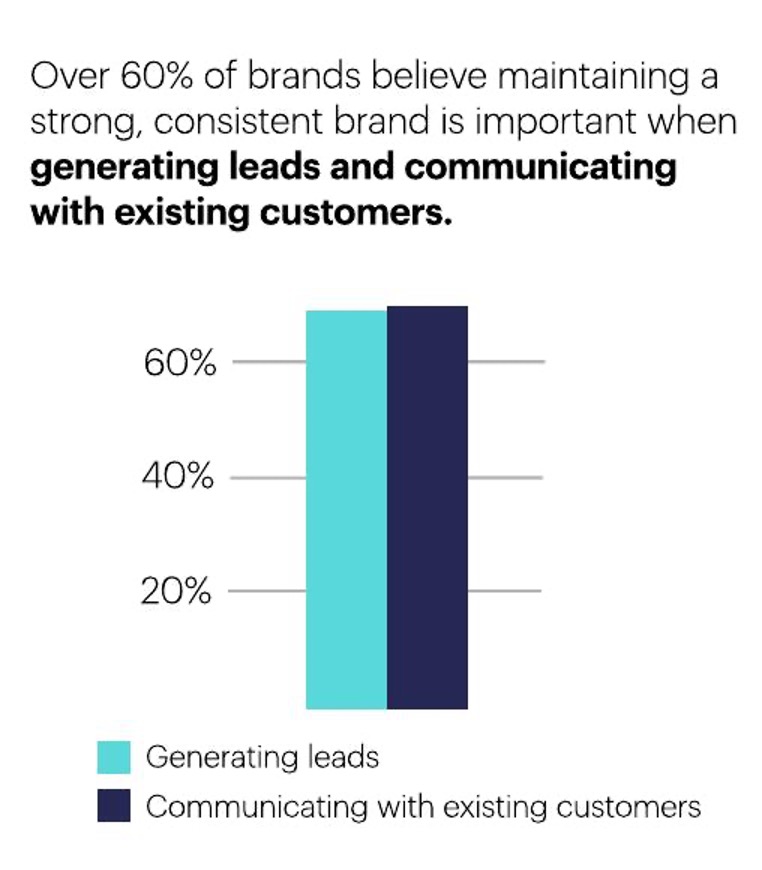
For retailers, brand consistency also starts with recognising the customer journey. This means identifying how your customers engage with your brand along multiple touchpoints. For example, if they visit your website, then choose to ship to a store, or visit your physical store to try on products which they will then purchase online. According to McKinsey, performing well on customer journeys is 35% more predictive of customer satisfaction than performance on individual touchpoints. In the end, omnichannel retailing is only as powerful as your brand identity.
If brick-and-mortar stores are still a priority for you, consider store solutions like pop-up displays to educate customers on your products. Other elements like music or lighting will also go some way to communicating your brand’s personality. Whatever you choose, you should implement the same conscious design and stylistic choices across all of your stores, as well as online.
Using Brand Consistency as a Growth Strategy
In 2020, Deloitte concluded that purpose and authenticity were the keys to future retail solutions. Without these two qualities, consumers cannot connect with brands and lose interest in purchasing their products. For retailers, brand consistency provides a way to communicate your brand’s purpose and ensure you appear as authentic as possible.
But brand consistency for retailers isn’t just about implementing a few changes across your online and in-store assets and leaving it at that. Your brand identity needs to be consistently maintained and, in some cases, altered to reflect your customer’s priorities. As such, brand consistency should form part of a retailer’s growth strategy which it returns to frequently.
For example, millennial and Generation Z consumers behave very differently from other generations, and companies have to adapt to keep their brands relevant. For example, millennials ascribe more value to brand purpose than older generations – 62% of millennials favour products that promote their social or political beliefs, compared to 21% of people aged 55 or older. The same is true of Gen Z, 60% of whom say it is important that brands value their opinions.
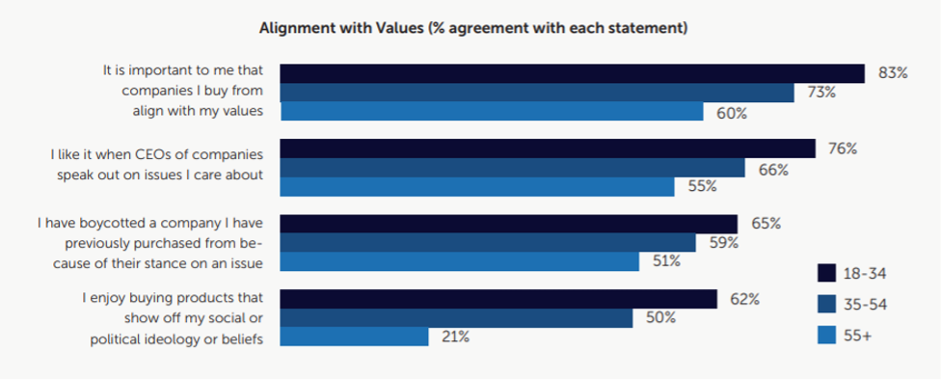
The results are even starker for Generation Z, who by 2026 will make up the largest consumer base in the US. They differ from millennials in their motivations for buying and how they make purchasing decisions. Whereas millennials may be interested in brand status – buying a product for the brand name – Generation Z is more interested in purchasing products that make them stand out, regardless of brand. Brand consistency for retailers will become even more important to appeal to the Generation Z market. There will be an increase in social media marketing spending plus a focus on making physical stores more of an experience than the traditional brick-and-mortar store.
In the end, evidence shows that investing in your brand identity will have long-term benefits. Strong brands consistently outperform averages for the market. McKinsey research shows that the top 40 worldwide brands have outperformed the Morgan Stanley Capital International benchmark every year for the last 13 years. It’s also true that when consistently maintained, a strong brand identity can drive a 10-20% increase in overall growth.
If you can entice the Generation Z market with your brand identity, you’re also going to see lifetime pay-off – 66% of Gen Z shoppers said that once they find a brand they like, they will continue to buy from them for a long time.
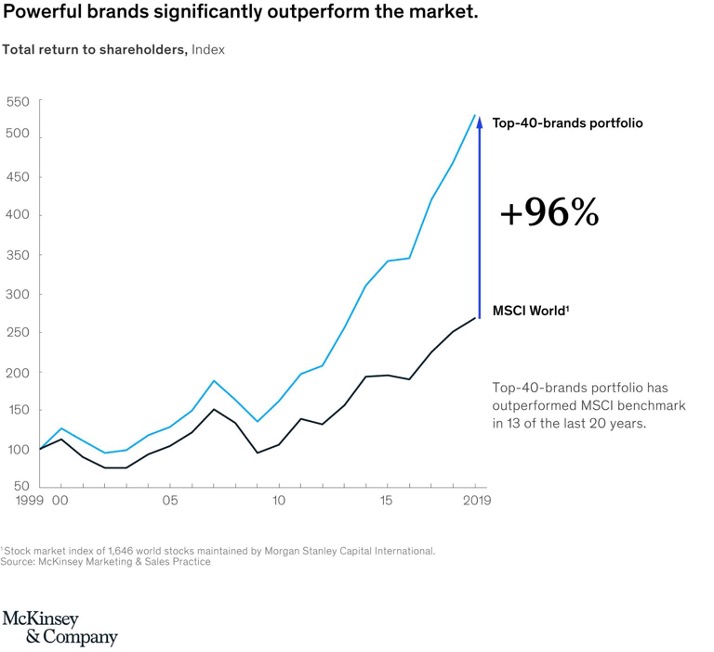
Delivering a Seamless Experience for Customers
Cohesive and compelling brand identity will inevitably inform your customer experience – that is, how your customers experience your brand in-store and online. A seamless experience is paramount to the omnichannel retail experience, and retailers cannot get this right before first evaluating how seamless their brand identity is.
We also know that customers want an easy shopping experience as much as a compelling brand identity. The consequences of a bad shopping experience for some consumers can be dire for brands.
Despite their brand loyalty, 64% of Generation Z consumers said they would switch to a competitor after multiple negative experiences with a company.
If you’re taking advantage of omnichannel retailing, not only is brand consistency for retailers across numerous touchpoints important but also executing a seamless shopping experience. Customers want to know they can purchase the products they want, whether they’re shopping online or in-store. A consistent brand experience will also bolster a consistent brand identity: undoubtedly, omnichannel experiences and brand consistency for retailers go hand-in-hand.
But how can retailers build an omnichannel retail experience that also promotes brand consistency? Firstly, retailers should take advantage of customer service technology such as chatbots. Research shows that new generations of consumers are far more comfortable interacting with virtual assistants than older generations. 40% of Gen Z and millennial customers agree that when in a hurry, they would rather interact with a chatbot than a human customer service agent. Chatbots can also be customised to reveal a brand’s personality in their tone of voice and language use, so not only do they promote a seamless experience bus also bolster brand consistency for retailers.
Additionally, retailers should build an omnichannel experience at every stage of the customer’s journey. Customers should have the option to return items either by post or in-store at their chosen location. This opens up further in-store interactions, which we know can often result in additional sales, as well as providing that effortless shopping experience that consumers desire.
No matter how you go about building an omnichannel experience, companies agree that building a seamless experience is one of the most significant factors in growth; 21% of companies agree that customer experience is the most exciting opportunity for brands. However, customer experience can also be a way to enhance brand consistency for retailers, and technology like inventory software can aid that.
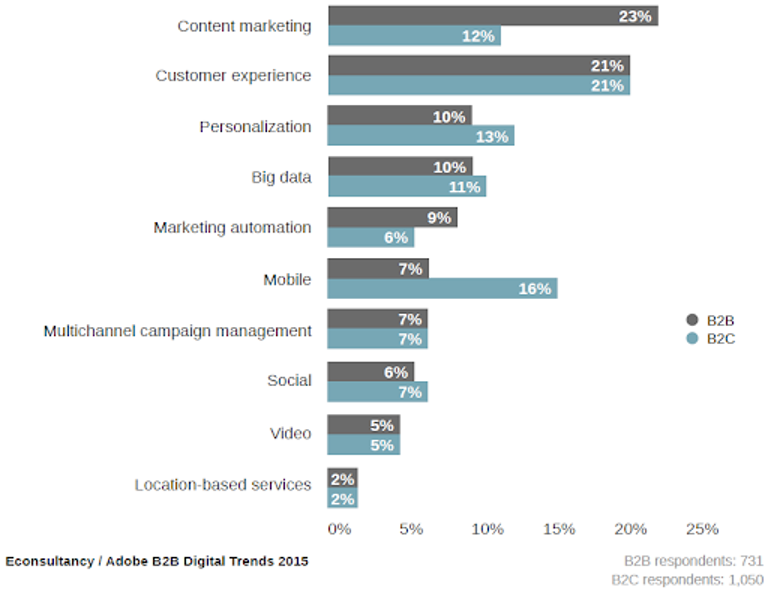
How Inventory Software Can Help Improve Brand Consistency For Retailers
Earlier this year, we examined how brick-and-mortar stores are adapting post-pandemic. Currently, one of the biggest challenges for retailers is keeping consistent levels of stock across physical stores and online, and this has only been exacerbated by the ongoing supply chain crisis. However, providing a consistent experience hinges on providing the products your customers want when they want them. Not providing this can have drastic consequences for sales; 96% of shoppers have left a store without purchasing anything because they couldn’t find the exact product they wanted.
Over the last two years, increased dependence on online retail has also prompted retailers to consider their operations. Retailers are now expected to fulfil orders made online, on mobile, and in-store simultaneously, requiring more accurate fulfilment systems and inventory tracking.
When it comes to retail solutions that improve brand consistency for retailers, there is only one: inventory software. Inventory software can provide retailers with real-time visibility of where their stock is, whether in a distribution centre, in-store, or in transit. This transparency is crucial to keeping up with consumer demands and increasing customer satisfaction and providing seamless brand consistency for retailers across multiple touchpoints.
Nike is one of the brands using inventory software to create a more successful omnichannel retail strategy. Starting in 2019, they implemented RFID technology in almost all of their non-licensed apparel and footwear, a decision that started to pay off during the supply chain issues of 2020 and 2021.
The company saw a 75% increase in digital sales over the pandemic, one-third of their total revenue. The real-time data that RFID provided offered Nike greater insights into customer buying journeys and the popularity of products. As a result, they could easily respond to customer demand and divert products to where they were selling best.
However, deploying RFID with inventory software like Detego’s has also allowed Nike to enhance their brand identity further. By harnessing technology like RFID, Nike has transitioned from selling mainly to wholesale partners to selling directly to consumers: they call this the “consumer direct offensive.” As well as embracing omnichannel retailing, this has also been a way for the company to enhance their brand identity by interacting directly with customers.
Brand consistency for retailers and omnichannel selling work together, and inventory software like RFID is the tool that can enhance both of these crucial parts of your business. Book a consultation with Detego today to find out how RFID software can improve your omnichannel success and enhance your brand identity.

Cloud-hosted RFID software
Stock accuracy, on-floor availability, and omnichannel applications in stores.
Book a demo with Detego to find out how our cloud-hosted RFID retail solution could help you improve your stock accuracy. With fast and easy results and application, our all-in-one software provides intelligent stock takes, improving the efficiency of your omnichannel services.
Traditionally, Black Friday has been one of the most successful times of the year for retailers. The total amount of sales during this period – especially online – has only increased year on year, and by employing effective performance solutions for Black Friday, retailers can often outperform their yearly KPIs in this one weekend.
However, this year is set to be different. Companies are already grappling with the ongoing supply chain crisis, but long-term changes to the retail sector make this year more difficult for retail businesses.
Research has shown that the retail industry is one of the most disrupted of all sectors. This disruption comes from all areas, and isn’t just limited to supply chains or the result of the pandemic. 43% of senior retail executives say the shift towards e-commerce has had a major impact on their organisation, but this is closely matched by other factors. These include evolving competition (38%), data privacy issues (37%), shifts in consumer demographics (35%), and technological advances (34%).
Not only is disruption affecting all areas of retail operations, but senior executives lack the confidence to tackle this disruption. Just 40% of retail leaders feel confident that they can survive the current disruption. To tackle this disruption, more innovative performance solutions for Black Friday are necessary to improve upon last year’s sales.
Despite the disruption, this Black Friday 2021 still looks promising for retailers. Online sales continue to increase, following a broader trend in retail but also as a reaction to the pandemic. Holiday spending this year is forecasted to increase by 10% compared to last year, while e-commerce is up 45% compared to 2019. Retailers can easily capitalise on this drive towards spending by pre-empting demand and turning to new performance solutions for Black Friday.
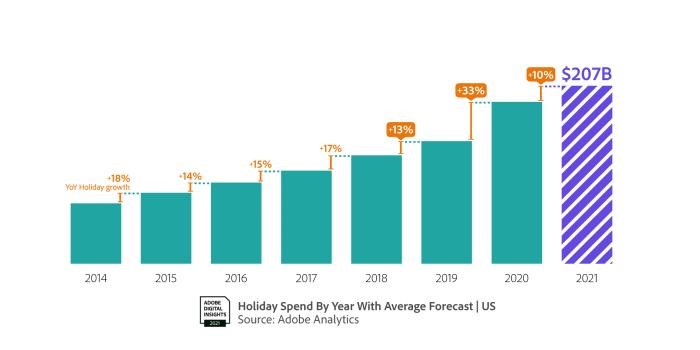
No matter which retail solutions leaders want to prioritise this year, they will undoubtedly be informed by digital transformation – 53% of retail organisations are choosing to invest in new technology to combat ongoing and future disruption. Whether that’s inventory software like RFID or improving their omnichannel customer experience using other forms of retail technology, there are a wide range of digital performance solutions for Black Friday for retailers to take advantage of.
The Current Issues Affecting the Retail Environment
The retail industry is going through a period of sustained volatility, with much of this uncertainty being driven by the on-going supply chain crisis and the recovery from the pandemic. Earlier this year, we looked into the supply chain crisis in detail, examining how the crisis got to this stage.
Unpredictable consumer demands mean that the supply chain crisis has been building for a long time. However, incidents like the pandemic, the blockage of the Suez Canal by the Ever Given container ship, and labour shortages all exacerbated the problem. Just the Suez Canal blockage alone caused an estimated loss of $9.6 billion worth of goods each day.
But how can businesses adapt to the crisis? The biggest change retailers can make is to embrace digital solutions such as AI-driven forecasting and cloud software. But as 87% of retail executives now agree that disruption is a primary challenge confronting both business and society, it’s clear that there is more uncertainty in the future retail landscape. Though we’re seeing the first signs of recovery from the pandemic among retailers, there’s still a lot of change to come.
Whether that’s the increased use of AI in customer service, the rise in e-commerce, new forms of payment including virtual currency, or tackling large competitors like Amazon, the industry is changing rapidly. Now, retail solutions don’t just need to respond to crises as they happen but also anticipate periods of uncertainty and volatility. As a consequence, retail performance solutions for Black Friday should offer short-term growth and long-term investment in technology to future-proof retail operations.
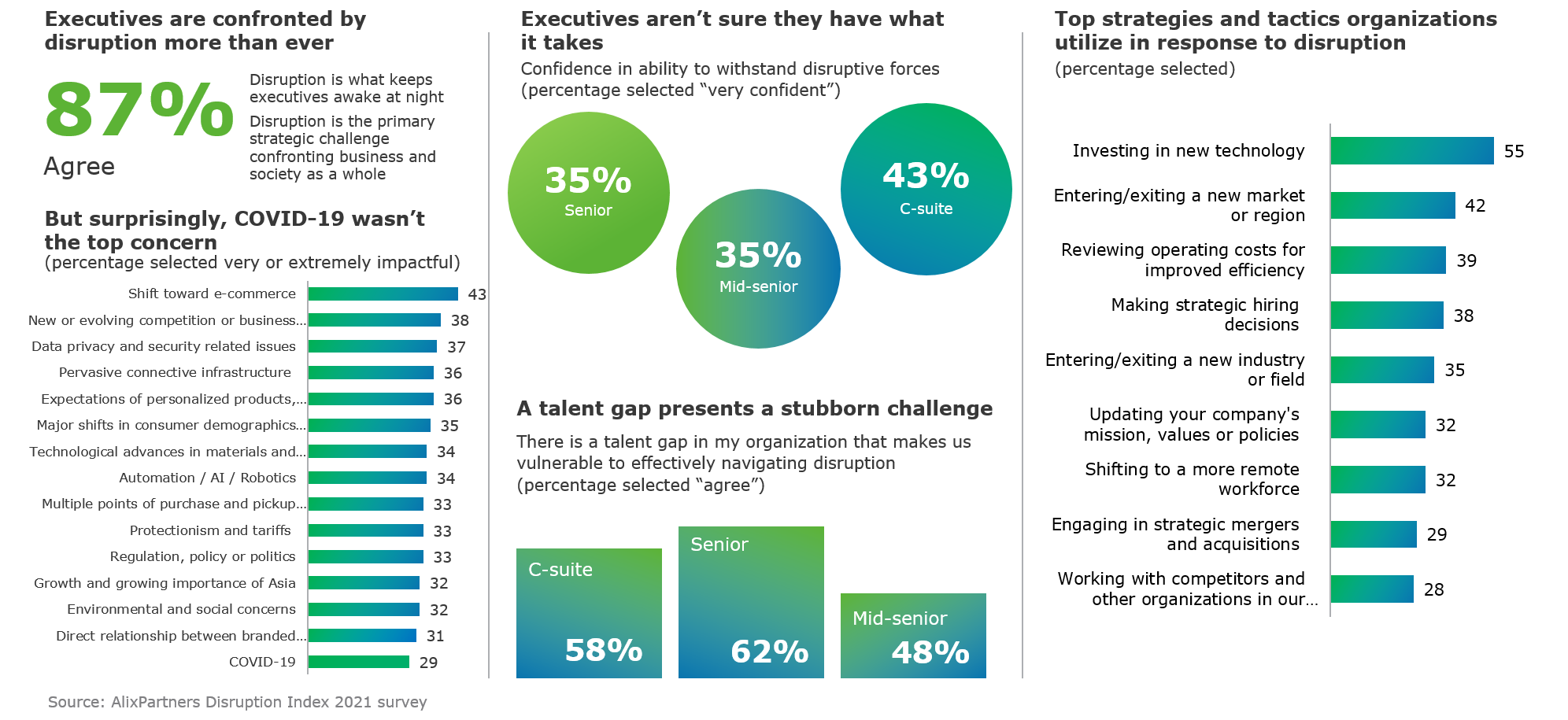
How Consumers Are Changing and What This Means for Retailers
As businesses consider retail solutions to survive this long period of volatility, it’s worth noting that consumers are also changing. With issues like sustainability and omnichannel retailing becoming new priorities for consumers, businesses can no longer rely on outdated performance solutions for Black Friday. Instead, digital retail solutions like RFID allow retailers to anticipate consumer demand and successfully respond to new trends.
The largest chain in consumer habits has come with the rise of Generation Z consumers. These shoppers have increasing disposable income yet are more concerned than older generations with where they spend it – 70% of Gen Z consumers say they monitor their spending more carefully as a result of the pandemic. As such, any proposed performance solutions for Black Friday need to consider their concerns and habits.
In addition to this, Gen Z consumers are more likely to take advantage of omnichannel retailing. More so than the average customer, they want to shop whenever and however they like. They are 56% more likely to shop in-store for goods, but at the same, also 38% more likely to shop online than other generations. Consequently, performance solutions for Black Friday need to consider how to provide an omnichannel experience. In some cases, business leaders should also consider adding additional services like shipping products from a select store or returning to any store the customer chooses.
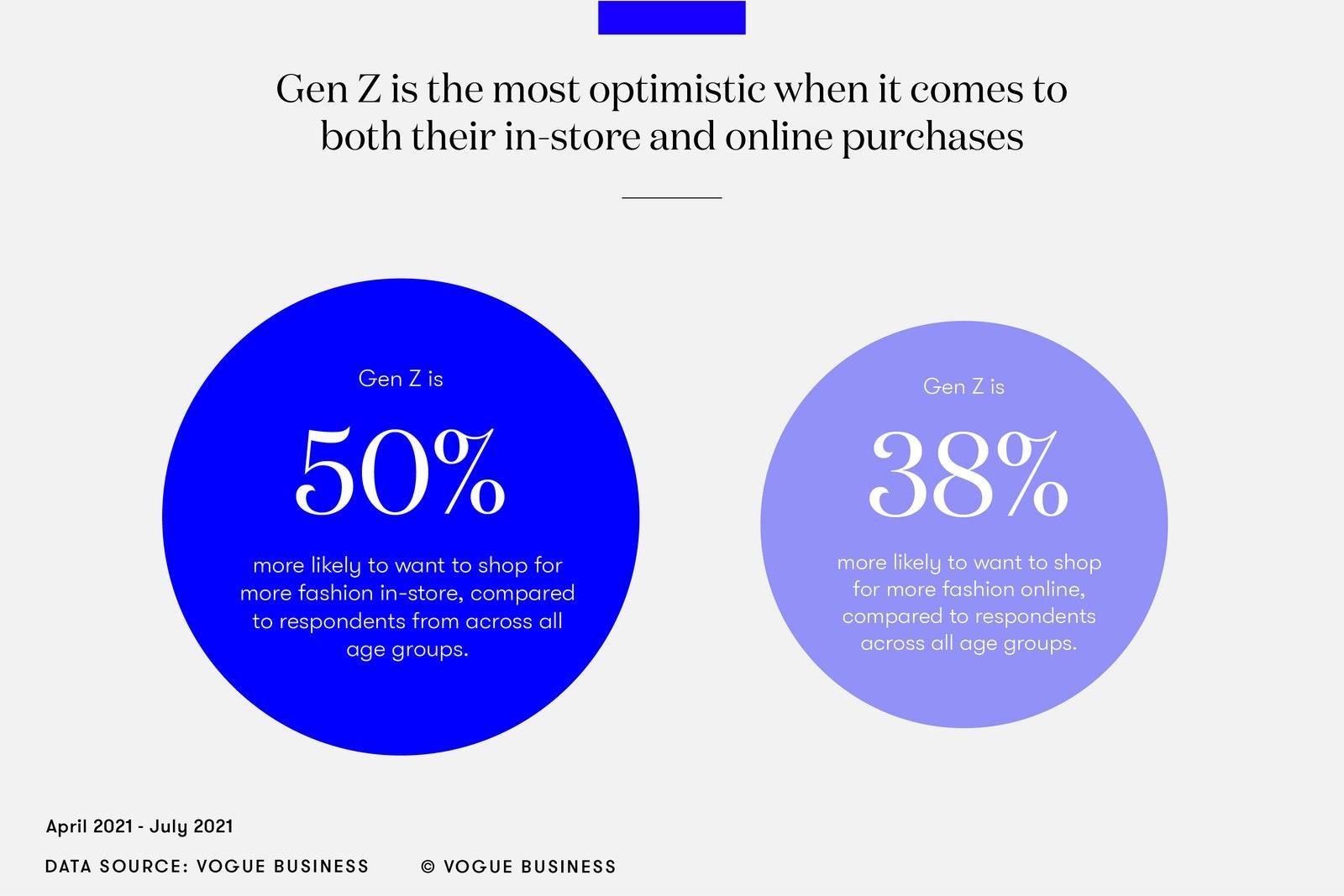
The importance of omnichannel retailing cannot be underestimated. One survey from Harvard Business Review found that though just 7% of customers shopped exclusively online, 73% actively moved across multiple channels, favouring both in-store and online experiences. The omnichannel customers liked to use multiple touchpoints with brands and were also keen users of in-store digital tools like price checkers and interactive catalogues.
In short, the new generation of consumers can flexibly move from in-store purchases to shopping online. However, despite this move towards online purchases, they still predominantly shop in-store – over half of digital-savvy consumers still choose to shop in-store, with 49% of consumers valuing being able to visit showrooms and then purchase those products online. This means that you need to prioritise store solutions as much as online and omnichannel retailing.
Generation Z consumers are also more likely to be concerned with the environmental impact of their purchases. With COP26 – the UN’s Climate Change Conference – having just ended, fashion retailers are just one of the industries committing to store solutions that prioritise sustainability. Thanks to the pandemic and the global spotlight on climate change, six out of ten Gen Z consumers are more conscious about the items that they buy.
Last year, we examined the recommerce and rental trend among retailers, predicting that it would be one of the biggest retail trends of this year. While consumers are driving demand for a circular economy, bringing a recommerce environment to stores brings its own unique challenges. The most complicated of these challenges is how to track a large amount of unique inventory through the supply chain and into stores. One solution to this is RFID tagging, which when combined with the use of inventory software can give retailers more accurate stock counts.
So, what does all this mean? Primarily, it shows that businesses should prepare performance solutions for Black Friday that prioritise the customers of the future – shoppers who want uncompromised accessibility to products wherever they are and new ways to purchase and return their products.
How to Navigate the Challenges of a Volatile Retail Environment
Most importantly, newly implemented performance solutions for Black Friday should tackle how to outperform this year, but also in years to come. Reliance on digital products like inventory software and AI will only increase in the retail space, and businesses that anticipate this will get ahead of the competition. For example, RFID is experiencing what McKinsey is calling a ‘renaissance’ in retail, with technology costs having fallen while new innovations mean even more cost-saving benefits for retailers.
With just a couple of weeks to go, some businesses may not be ready to implement new performance solutions for Black Friday. However, Christmas is also just around the corner, providing another chance to outperform before the end of the year. While January sales don’t reach the same peak as Black Friday – when businesses often make up to 20% of their sales revenue for the entire year – they are still valuable.
Technology and Analytics
Digital transformation is a crucial phrase for retailers when it comes to tackling periods of uncertainty. Still, performance solutions for Black Friday that focus on innovative technology can offer retailers the chance to outperform competitors.
Retailers that harness solutions like predictive customer analytics will know exactly what consumers are looking for and which products might be most in demand during Black Friday and Christmas shopping. Retailers who employ AI have seen a collective $40 billion worth of additional revenue over a three-year period.
Inventory software is another innovation that will make busy shopping periods more seamless for retailers, with 46% of companies having already implemented RFID as a reaction to the pandemic. We know that use of RFID will only increase, making it a promising performance solution for Black Friday for retailers to consider.
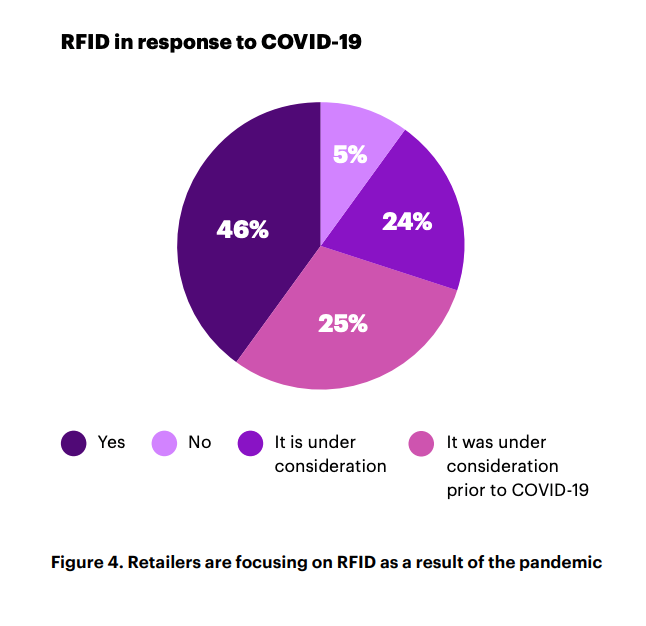
Re-imagining the Brick-and-mortar Shop
The pandemic has dramatically accelerated the pace of digital transformation in retail supply chains and stores. Over just a few months during the pandemic, executives have implemented close to three or four years of digital innovation in their companies.
Globally, 58% of business interactions with customers are now digital, an acceleration of three years compared with the average year-on-year increase. Consequently, businesses who want to implement successful performance solutions for Black Friday will inevitably turn to technology.
However, it’s also true that consumers may harbour anxiety around shopping in-store for some time. Though it’s unlikely that measures like one-way floor plans and plexiglass screens will stay in place for much longer, retailers will need to reimagine the in-store experience with the consequences of the pandemic in mind.
This might include incorporating aspects of digital experience in physical stores, such as intelligent AI personal shoppers on the customer’s phone or digital mirrors in changing rooms that can provide product recommendations in real-time. These store solutions will reimagine the pre-pandemic store, and take advantage of digital innovations that customers will be seeking in the future.
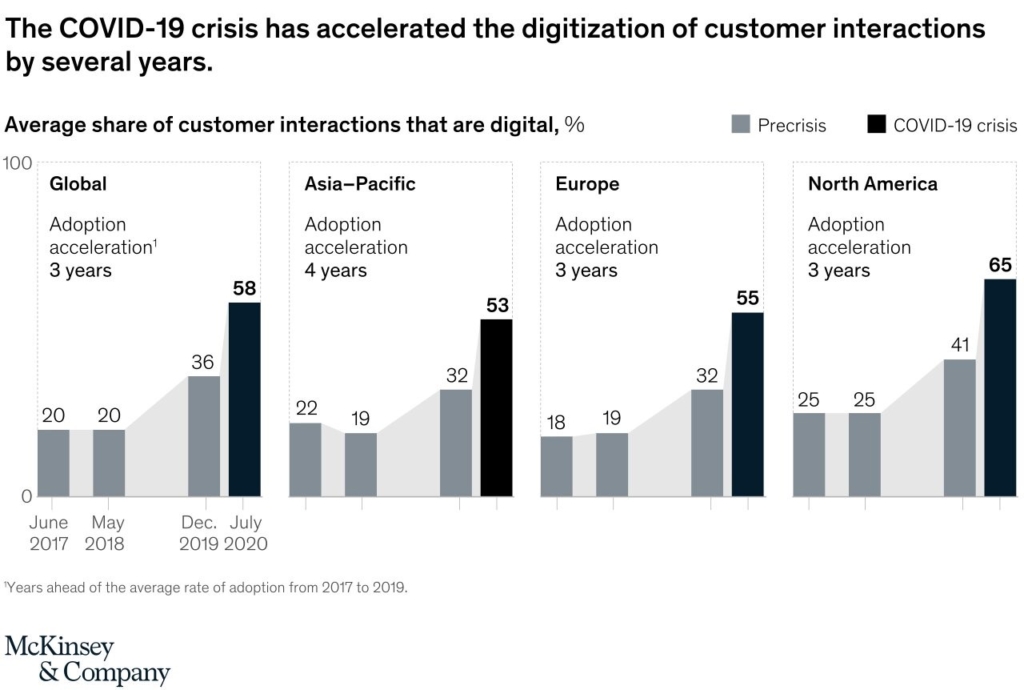
Omnichannel Retail
Perhaps the biggest retail solution has to be the shift towards omnichannel retailing. Stores can no longer solely exist in a physical or online space but a combination of the two. It turns out that omnichannel customers are also more valuable for businesses, spending on average 4% more on every shopping occasion in store and 10% more online than the average single-channel customer.
We know that consumers want omnichannel experiences, but implementing a performance solution for Black Friday that incorporates this may be more difficult. Inventory software like RFID tags is one solution, offering retailers a way to track stock across the supply chain, both in warehouses and online.
RFID as a Performance Solution for Black Friday
Especially at times of increased volatility and demand, more accurate stock inventory is one of the easiest ways to improve your company’s performance. This is even more important right now when supply chain issues make it more difficult to get an accurate picture of your inventory. Inventory software is the ideal performance solution for Black Friday, offering retailers an accurate picture of stock and the ability to navigate periods of increased demand successfully.
Preventing Out-of-stock Notices
Research from RetailEXPO has revealed that 31% of customers want retail employees to help them with out-of-stocks. This is crucial during Black Friday when demand will be higher, and customers may be looking for specific items in sales. Retailers who have adopted inventory software like RFID will be more likely to uncover new stock, having insights into where the same shipments and products are in their supply chain journey.
Omnichannel Retailing
While there will be an increased number of shoppers heading to physical stores this year, many Black Friday shoppers will still resort to online purchases. RFID easily allows retailers to keep track of stock across online and in-store sales and offer customers the chance to pick up their purchases in-store. As reliance on a mix of channels grows, inventory software is crucial to accurately track stock, increasing performance during times of increased demand like Black Friday.
Detego’s all-in-one retail solution gives you the tools to command complete transparency over your supply chain and inventory. We harness the power of RFID alongside an end-to-end SaaS inventory software platform that improves inventory accuracy.

Cloud-hosted RFID software
Stock accuracy, on-floor availability, and omnichannel applications in stores.
Book a demo with RFID to find out how our cloud-hosted RFID solution could help you outperform during busy sales periods. Our multi-user app can provide intelligent stock takes and a smart in-store replenishment process and later, you can scale the solution to offer omnichannel services and effectively manage your entire store operations with real-time, item-level inventory visibility and analytics.
Detego and Microsoft partnered on this retail success story.
How an iconic British fashion brand and retail store chain successfully increased the availability of items in-store while improving the customer experience.
“It was also around gaining visibility for our omnichannel journey. If you look at those as different challenges, RFID provided a solution that enabled us to use technology to enhance all that.”
Complete the form below to download the case study.
This year’s Christmas period will be unlike the ones before. With retailers just recovering from or still grappling with supply chain issues and facing potential staff shortages caused by Coronavirus and other extenuating circumstances, it’s going to be more difficult to hit yearly KPIs.
However, the retail forecast for the final quarter of the year still looks promising. Deloitte predicts that holiday sales will grow by 7% to 9% compared with the same period last year, and retailers should focus on taking advantage of consumer demand this Christmas. While retailers can expect high demand for products this year, there are additional ways you can improve store performance.
Not only do physical retailers have to compete with online purchases in the run-up to Christmas, but there is also increased pressure to make up for any lost performance from earlier this year due to the dual crises of the pandemic and supply chain problems.
There are many retail solutions for improving store performance, ranging from implementing omnichannel marketing to improving customer service. Most store solutions come down to accurate inventory counts. Knowing the stock you have, where shipments are, and what products you can offer the consumer will inevitably improve the customer experience and your overall store performance this Christmas. For this reason, you should consider retail solutions like inventory software as part of a strategy to improve performance.
Our suggestions for store solutions are just a start. To successfully improve store performance this Christmas, retailers should take a 360-degree view of their operations, from their supply chain to stock replenishment and customer expectations of their store. Inventory software like RFID tags will go a long way to tackling some of these issues.
While a switch to digital inventory solutions will take time and training to implement successfully, it’s a long-term solution that will protect retailers against future supply chain issues and ensure optimal customer satisfaction in your stores.
A difficult Time for Retailers
If your store is struggling to reach its KPIs this year, you’re not alone. Supply chain issues – partly caused by the Coronavirus crisis – have made it more difficult for stores to get the stock they need this year, leading to reduced sales and performance.
These issues exist all the way through the supply chain and are not limited to one geographical region or country. Around 38% of ocean freight was delivered on time this year, half of last year’s total. Consequently, prices for raw materials and delivery are rising, on top of increased demand from retailers for their stock.
Stores experiencing a drop in their stock availability are already witnessing the effects on their total profits this year. Maternity wear retailer Seraphine reported lower stock holdings from July onwards, which meant they couldn’t satisfy customer demand in-store. Consequently, the retailer now predicts a 15% reduction in profits compared to last year.
As demand for products increases in the run-up to Christmas, many retailers are consequently over-ordering or placing retail orders too early to get their stock inventory back to normal levels. But this is far from an ideal retail solution and creates issues further up the supply chain for raw materials manufacturers.
Stores that can anticipate stock issues and respond to them quickly will have a better chance of weathering the supply chain crisis and improving their performance – which is more important than ever as the retail sector prepares for increased demand over Christmas. To do this, retailers should take advantage of inventory software.
The importance of inventory accuracy
There are many ways to improve store performance, from focusing on the overall customer experience to automation and omnichannel marketing. Most of these store solutions have in common, though, is the problem of accurate stock inventory. If retailers are going to recover from the ongoing supply chain crisis successfully, then a 360-degree view of operations and stock levels is crucial – and inventory software can help you do this.
Tracking and cataloguing store inventory isn’t limited to the shop floor. Retailers must have a broad view of their inventory from the end of the manufacturing process to when a shipment arrives at the store warehouse. Tracking such a large amount of stock – for some retailers, this can mean processing 70,000 items in just a few months – requires its own digital solutions, which can take time to implement. However, the impact of such inventory software is significant.
Missing stock on the shop floor is a massive problem for physical retailers, especially in the wake of supply chain issues. The digital age has transformed customer expectations, meaning that physical stores must compete with online retailers. Now, if customers are disappointed by product availability in-store, their solution is to order the same product online.
To put this into perspective, 75% of millennial shoppers leave a store without a purchase instead, buying that item online. The main reason for this? It’s encountering out-of-stock items in the store.
Accurate stock inventory is also key to providing a successful omnichannel customer experience. Especially in the busy Christmas period, customers will be looking for flexibility in the shopping process, including options to collect their products in-store, order online for in-store pick-up, and even in-store ordering to their home. This omnichannel approach to the shopping process inevitably increases the chance of a successful sale and makes the entire experience effortless for the customer.
In all of these cases, inventory software is the tool that will enable retailers to have a broad view of their entire stock inventory, from warehouse to shop floor. Technology like RFID can transform your strategy to retailing by making it easier to perform stock counts, track products across the shop floor, and make informed decisions about your retail strategy
Why RFID is thriving
Radio-frequency identification (RFID) has fast-evolved from a technology used at the fringes of retail, to a global technology that is delivering business results to retailers everywhere.
According to a recent study published by Accenture:
- The majority of retailers (80%) said the benefits of RFID cannot be replicated by another technology.
When fitted to a product at the manufacturing stage, an RFID tag will send continuous data to a reader as long as it is in range. This tag removes the need for laborious stock taking with a barcode scanner, as the reader will scan everything in range and catalogue it – even if the product is in a boxed shipment.
Used alongside inventory software, RFID can produce accurate stock counts, track stock from the factory to the warehouse, and work alongside other technology in-store to create a personalised experience for customers.
With accurate stock counts becoming more important as the busy Christmas period arrives, inventory software like RFID is a valuable store solution that can easily improve your store’s performance.
How Inventory Software Can Improve Store Performance
With a digital inventory solution like RFID, retailers can solve the problem of inaccurate stock counts, which become even more important during times of increased consumer demand. It can also improve the omnichannel customer experience by giving consumers more transparency about where products are and how they can purchase them – all of which will improve your store performance in the long run.
Keeping Shelves Fully-stocked
We know that one of the biggest problems for retailers is keeping shelves fully stocked and the consequences of out-of-stock products. While you can expect some stock disruption with supply chain problems, RFID can alleviate some customer pain by ensuring shop floors are as full as they can be under the circumstances.
This digital store solution will allow you to take frequent inventory counts – up to twice a day, compared to the average of once or twice a year. When used with inventory software, you can also get on-time recommendations for which products to refresh on the shop floor, ensuring that no customer ever leaves disappointed.
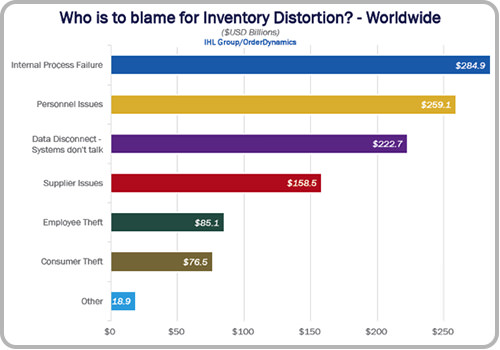
This digital store solution will allow you to take frequent inventory counts – up to twice a day, compared to the average of once or twice a year. When used with inventory software, you can also get on-time recommendations for which products to refresh on the shop floor, ensuring that no customer ever leaves disappointed.
Improving the In-store Customer Experience
Nowadays, customers want more from their physical stores. Whether that’s more personalised recommendations from staff, virtual shop assistants, or interactivity in-store, RFID can help you do this.
RFID tags can work with other innovative technology like smart fitting room mirrors to offer personalised product recommendations for customers while shopping in your store. When a customer takes a product fitted with an RFID tag to a fitting room, the product’s unique code is read, and the product is displayed on the smart mirror, alongside similar products that the customer may like to try. There may also be the option to request products while in the fitting room, making the shopping experience more seamless for the consumer.
Producing Accurate Data
For retailers to successfully navigate the increased demands of the Christmas period and ultimately improve performance, accurate data is crucial. RFID is a digital tool that provides real-time data about stock levels and makes suggestions about managing inventory better.
Instead of relying on historical data for your in-store stock decisions, RFID gives you the tools to make informed decisions about your store. From stock availability to automated refills and data on dwell times, this inventory software will improve performance in your store through more accurate insights.
Offering Omnichannel Retailing
It’s no longer a battle between brick-and-mortar stores versus online, but most retailers are a hybrid of both. This means that your stock inventory needs to be more precise and accurate, reflecting both your in-store availability as well as online, so customers can get exactly what they want whether they’re in-store or at home. The key to omnichannel retailing is ensuring there are enough options for your customers – whether they want to pick their product up in-store, order it to their home, or return it to a different store, there should be a retail solution for that. For this to work, retailers need an accurate view of their stock counts and where stock is at all times. By utilising RFID with all-in-one inventory software, you can achieve up to 99% stock accuracy, meaning the customer is never disappointed by out-of-stock notices or unavailable shipping.
Why You Should Invest in Inventory Software now
Retailers gear up for increased consumer demand, inventory software and RFID can be a valuable retail solution in the run-up to Christmas by eliminating labour-intensive stock counts and improving stock visibility from warehouse to shop floor.
Retailers are increasingly investing in inventory software like RFID to streamline their supply chains. In the US, investment in retail technology has reached $8.6 billion, reflecting its value as a store performance solution. It’s a similar story in the UK, where technology like inventory software could uplift £21 billion to the retail sector.
Not only will more accurate inventory information make your operations more effortless and reduce labour requirements, but it will inevitably improve store performance. You can use a store solution like RFID to strengthen omnichannel retailing and provide increased personalisation in-store, leading to more opportunities for sales. Ultimately, RFID is an ideal retail solution for periods of increased demand, such as the run-up to Christmas.
Detego is the only all-in-one retail solution on the market, utilising RFID alongside a complete end-to-end SaaS platform to improve your inventory accuracy. From stocktaking and stock replenishment to tagging, our inventory software can handle it all, reducing the chances of human error and increasing opportunities for sales in your stores

Cloud-hosted RFID software
Stock accuracy, on-floor availability, and omnichannel applications in stores.
Detego Store is a cloud-hosted RFID solution which digitises stock management processes, making them more efficient and more accurate. Implemented within hours, our multi-user app can provide intelligent stock takes and a smart in-store replenishment process. Later, you can scale the solution to offer omnichannel services and effectively manage your entire store operations with real-time, item-level inventory visibility and analytics.
Managing inventory levels is more vital now than ever before.
At the same time that out-of-season stagnant stock sits untouched in warehouses, desirable inventory is increasingly becoming short in supply on shopfloors. In fact, when slow-moving stock can still make up to 40% of a retailers inventory, it seems strange that the current shortage of goods is reportedly here to stay. But taking this juxtaposition into account, it’s not hard to predict that many more retailers will be feeling the strain of simultaneously being overstocked and out-of-stocked as the holiday season approaches.
At a time when struggling businesses could stand to increase revenue drastically, they will have to be more strategically minded, optimising the distribution of limited inventory and harnessing emerging opportunities to turn obsolete stock into profit. In order to do this, however, retailers will need to actively seek to improve their loss prevention processes as every item of stock – even obsolete inventory – becomes increasingly more vital to lifting the bottom line.
The Impact of Inventory Loss in the Post-Pandemic Environment
Due to the heightening imbalance of desirable and undesirable stock, it is no exaggeration to say that within the grand scheme of a retailer’s operation, even a single piece of inventory can drastically impact a business’s opportunity to make money or lose it.
For instance, with the circular economy booming, the slow-moving stock is increasingly being repurposed to recuperate costs, while inaccurate real-time product availability of popular goods could negatively hinder a retailer’s ability to build omnichannel relationships with customers.
That is why shrinkage – when a business loses inventory for reasons other than sales – is a driving issue for retailers and one that looks to exasperate the inventory challenges already at play.
Last year, shrinkage cost the US retail market $61.7 billion, and as supply chain disruptions continue, retailers will increasingly need to tighten their control over assets at an item-level scope, especially now that their distribution strategies are influenced by localised demand for particular product categories, styles, and sizes as customers continue to expect personalised and immediate services.
But to facilitate this level of customer service, improvements to inventory management must be made that prioritises precise inventory tracking and agile loss prevention.
Causes of Shrinkage are Becoming Increasingly Complex
To improve their loss prevention strategies, retailers must get to the root of the current shrinkage causes that are growing more wicked in nature due to inventory touch-points multiplying at speed. Here we explore the most coming reasons for stock loss in retail and why they are challenging businesses today:
- Returns Fraud
Social media has contentiously given rise to the trend that it’s “unfashionable” to be photographed in the same outfit twice, leading to a growing community of serial returners who consistently purchase fashion products, wear them once or twice and then return them. And as social commerce grows –generating more and more omnichannel touchpoints – so do the opportunities for fraudulent returns within this growing trend. Last year, scams involving the returns of products already cost retailers $43 billion, and in this year’s National Retail Security Survey 2021, retail companies reported that multichannel sales had created the most significant increase in fraud this year.

As customers continue to purchase online and then pick up orders in-store and vice-versa, the challenge for retailers is that they must cater to the growing demographic of digitally literate consumers who now move between online and physical touchpoints whilst implementing inventory traceability. Because if not adequately managed, omnichannel can open up opportunities for stock loss, with fraudsters taking advantage of any discontinuity between online and offline returns processes.
2. Shoplifting
Even with mandated closures for much of the year, 2020 saw UK retailers lose over £770 million from shoplifting alone. So now, with physical stores firmly back open, shoplifting has re-emerged as a critical challenge of retailers who are hoping to turn these spaces from loss-leaders to optimal environments for customer engagement.
Criminal activity in stores, however, not only poses a threat to the bottom lines of these operations but can also negatively impact the experiences of customers and employees. Especially now that many companies have begun to take a stronger social stance towards the wellness of their workforces. Retailers must from now on empower employees to handle shoplifting efficiently, confidently, and safely.
3. Employee Theft
Global employee theft is predicted to cost retailers 2.9 trillion annually and accounts for 28% of inventory loss, with physical goods most likely to be stolen from the workplace. Viewed as an epidemic within the retail ecosystem, there are many diverse existing approaches to loss prevention, from behavioural focused strategies such as staff recruitment and training processes to physical deterrents such as CCTV and POS data mining.
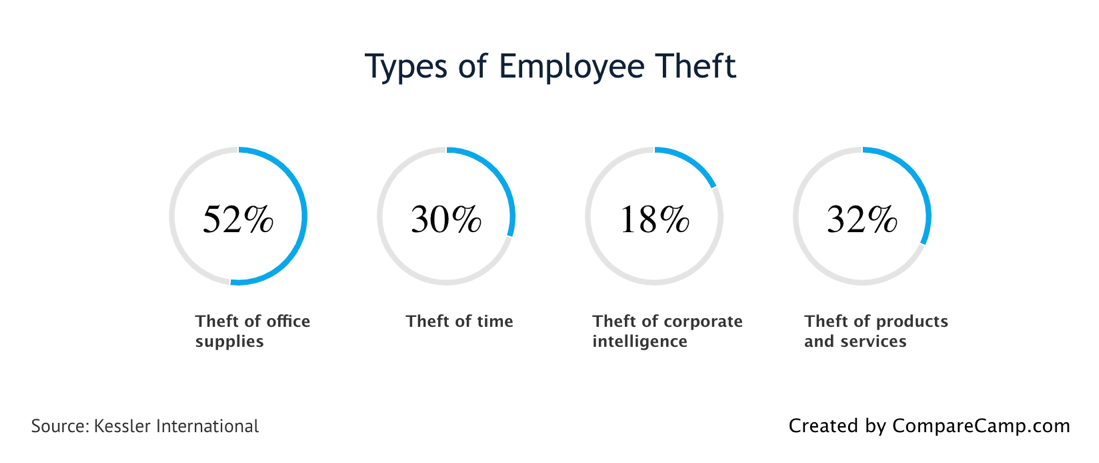
Product visibility is non-negotiable for retailers embracing omnichannel
The challenge for retailers who are tackling employee theft, however, is in how to build a connected and holistic solution that improves workforce attitudes and culture towards stealing, reduces opportunities for theft and at the same time incentivises them to become active players in inventory protection.
- Damages
It goes without saying that damages to inventory are inevitable. As goods that are often journeying to far-reaching locations, wear and tear in transit is to be expected and – although not ideal – retailers commonly anticipate this reality and reflect it within their financial accounting. At a time, however, where in-demand stock is in short supply, damages to assets is being viewed as a growing nuisance that, whilst wholly unavoidable, should be dramatically reduced.
But it is the reporting of damaged goods that should be a significant concern for businesses. Again, as consumer sentiments move towards fast fulfilment, retailers will need to have precise real-time insight into stock availability, and its location, yet unaccounted for damaged items can sabotage a business’s ability to carry out effective customer services.
- Administrative and Supplier Error or Fraud
Error or fraud in the reporting of inventory levels is a severe problem that multiple stakeholders can enact at any given time. It is vital to a retailer’s bottom-line that delivery of goods from vendors is 100% correct at the time of receipt. Whether intentional or not, incorrect data from suppliers could have knock-on effects throughout the supply chain down to stocktake on a shop-floor and incorrect e-commerce order fulfilment.
At the same time, what could seem like minor mistakes such as pricing or labelling errors can snowball into significantly lost profit, lapses in customer satisfaction, and employee frustration. And in fact, administrative and paperwork errors can account for 18.8% of annual shrinkage. In order to mitigate these errors, retailers must begin to explore how inventory data can be communicated correctly and consistently throughout these various internal touchpoints
Why Current Methods of Loss Prevention can Lack Long-Lasting Results
Loss prevention has to date, been an issue of high importance for the retail sector. Still, the recent acceleration of technology adoption has provided a window into the efficiency that digital-driven supply chain management presents. While current loss prevention methods are year-on-year, reducing the cost of lost goods, these solutions can often lack depth and breadth as they operate in silos from one another.
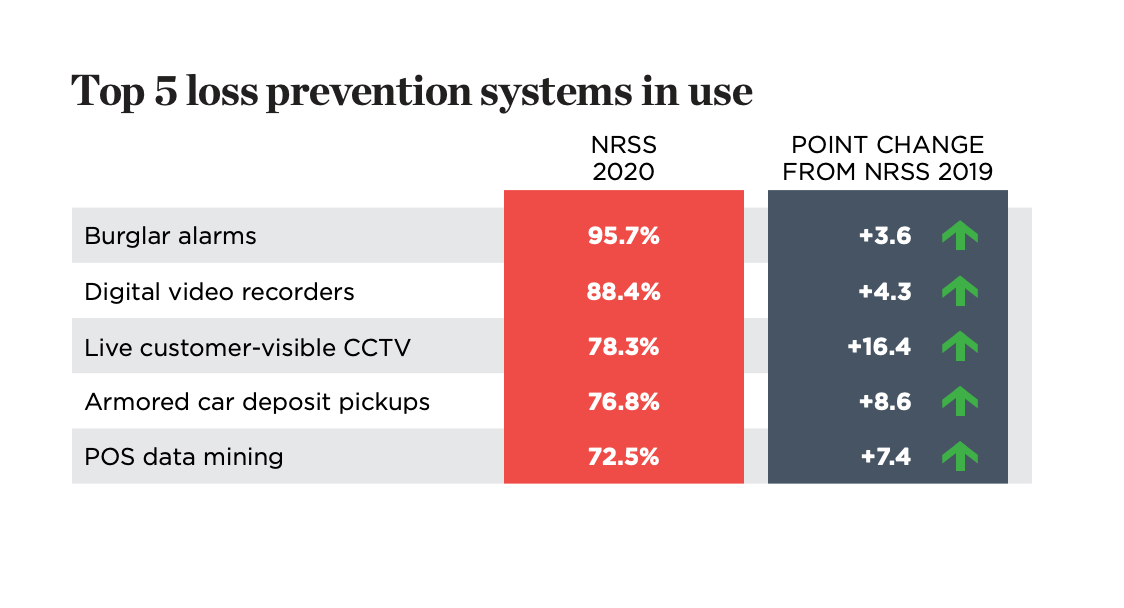
Additionally, many of these existing strategies, such as alarms and armoured cars – while effective – predominantly focus on mitigating the loss of large quantities of stock rather than at the item-level that is becoming increasingly important. At the same time, they often do not account for reducing back-end administrative fraud and errors such as incorrect delivery dockets.
It is, therefore, critical that continuity of information is built into future loss prevention strategies so that goods are traced throughout the entire supply chain, and long-term improvements can be implemented.
How RFID Can Prevent Shrinkage in One Simple Solution
Smart-Shelving
RFID’s ability to help retailers monitor how customers interact with their products to improve personalisation and recommendation in stores can subsequently work in favour of loss prevention. For example, RFID enabled smart shelving sends a trigger to employees whenever stock is low and can help report real-time anomalies of inventory movement and location tracking.
The technology’s ability to send stock quantities and location information to multiple stakeholders in stores, head-office and warehouses could act as a significant dissuade employees hoping to isolate incidents of theft. Additionally, the simple existence of an item-level RFID tag can act as an effective deterrent to shoplifters.
Returns Processing
Due to RFID being able to trace inventory throughout the entire supply chain, this software can act as a journal for any product, providing evidence of where it has been before being returned into a retailer’s ecosystem. In turn, this can allow businesses to identify where returns fraud is happening and assess where the weaknesses are in their returns process.
Data collected can also provide insight into the kinds of products experiencing serial returns and investigate if this is down to poor quality, fit, or even if the item is highly “Instagramable” rather than wearable. These are all essential datasets that can be fed back to designers, marketers and manufacturers who can, in turn, look to reduce the reason for returns within their roles.
Automated Real-Time Updates
The automated updates that RFID provides allow companies to manage inventory with more connectivity within their operations. Unfortunately, inconsistent communication between the complex and isolated processes within retail operations has for a long time provided the opportunity for administrative, human errors and fraud.
RFID simplifies communication and allows warehouses, distribution centres, and stores to correlate physical stock against digital information at the item level. Additionally, RFID removes chances for vendors and employees to tamper with data and falsify information.
RFID Can Makes Data-Driven Loss Prevention a Reality
Not only can RFID act as a deterrent, but it can also help businesses to build resilient future strategies that reduce the causes of inventory loss at the source.
As an offshoot of the all-important supply chain transparency we discussed last month and item-level visibility the retail sector still struggles to enforce, RFID’s ability to deliver data-driven insights and pinpoint precisely where inventory loss occurs is highly valuable for highlighting areas for improvement within the supply chain and possibly uncovering reasons for the unattributed loss.
Book a demo with Detego today to see how our inventory transparency software can help you tackle loss prevention challenges.

Cloud-hosted RFID software
Stock accuracy, on-floor availability, and omnichannel applications in stores.
Detego Store is a cloud-hosted RFID solution which digitises stock management processes, making them more efficient and more accurate. Implemented within hours, our multi-user app can provide intelligent stock takes and a smart in-store replenishment process. Later, you can scale the solution to offer omnichannel services and effectively manage your entire store operations with real-time, item-level inventory visibility and analytics.
Consumer mindsets are evolving at an accelerating pace.
While it wasn’t long ago that shoppers could be satisfied receiving the tiniest of details from a product’s journey before it came into their possession, years of unsustainable and unethical practices within retail supply chains have begun to tarnish the relationships between businesses and their customers.
Understandably, customers are increasingly demanding that the traditionally opaque supply chains that serve them are made more visible – and they’re using their wallets to back and promote these values. As a result, power has shifted, and unless retailers want to become obsolete, ignorance and dishonesty must be replaced with clarity and accountability.
Especially since — over the past 18 months — the pandemic has intensified this scrutiny, and it seems that now, for retailers to survive, they must relinquish their use of transparency as a novel marketing strategy and view it as a necessary process to be implemented into everything they do.
Transparency as a marketing tool is nothing new, businesses have been branding their performance as a method of storytelling that highlights their morality and pulls audiences in for a while now. Greenwashing, however, has become a concerning result of this trend, with companies picking and choosing what to report and positioning their activities in a positive light.
In fact, in the Business of Fashion’s and McKinsey & Company’s The State of Fashion 2020 report, almost 20% of executives claim that radical transparency is one of the top three themes impacting their business due to changing consumer desire for genuine and clear information.
What Does a Radically Transparent Supply Chain Look Like?
Radical transparency defines the complete disclosure of information at every link of a retailers supply chain. This includes everything from the sourcing of raw materials, water usage in textiles dying, factory working conditions, the environmental impact of goods distribution, and customer care instructions.
In the past few years, many organisations have led the charge regarding supply chain clarity. For example, in just the apparel sector exists Fashion revolution Eco-Age and Good on you – all of which currently hold fashion retailers accountable over the impact of their supply chains by taking different approaches to the promotion of reporting.
And reporting is the cornerstone of supply chain transparency, providing a window into the practice’s businesses abide by. H&M — leaders in supply chain transparency — are among many retailers who have aligned their manufacturing reporting with Transparency Pledge Reformation takes this a step further, making the environmental impact and traceability of their products public.
Yet, the widespread adoption of end-to-end supply chain clarity is limited and slow. While most businesses have begun to embed transparency into their internal operations and with direct suppliers, processes beyond their control – for the most part – remain opaque.
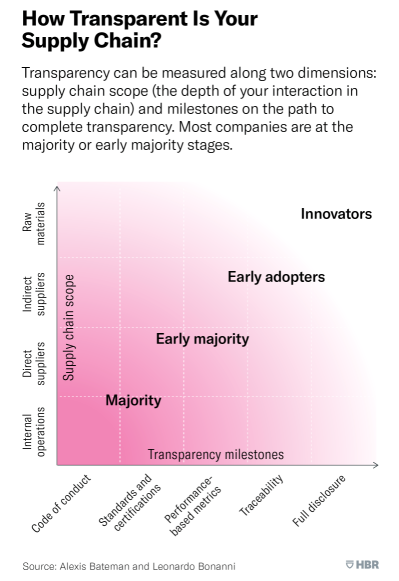
As a result, the companies that can trace their products’ raw materials are categorised as pioneers of supply chain transparency, whilst businesses that can track the activities of their indirect suppliers are ahead of the curve. Yet, for the majority of companies, moving towards full disclosure reporting can seem like an impossibly far milestone to reach. Nonetheless, it is one they must begin striving towards now.
Why Prioritise Transparency Now?
While many retailers readily look to improve their supply chain transparency, for many others, full-disclosure reporting is a practice being pressured upon them by both direct and indirect stakeholders. These different parties desire open and honest information for various reasons. Here we discuss the mindsets of these stakeholders and explore the reasons behind their demands for radical supply chain transparency:
1. Customers
The post-pandemic retail sector is filled with innovation that attracts the re-emerged consumer whose activism has been heightened by COVID-19. Multiple lockdowns had given the world time to re-evaluate its values, especially when last year, there was no good excuse to look away from societal issues that took the world stage, such as climate emergencies, poor factory conditions, and racial injustice. As a result, contemporary consumers are more scrutinising now than ever before and want the businesses they shop with to take accountability when problems within their internal operations are uncovered.
Sustainable and Ethical Practice:
It is arguably customers who drive retail’s interest for heightened clarity through their passion for advocating brands with sustainable products and ethical operations. In fact, 64% of shoppers look for ethical or sustainable features when making a purchase, and according to researchers at MIT Sloan School of Management, they may be willing to pay 2% to 10% more for products from companies that provide greater supply chain transparency.
In being able to see the impact of their purchases more clearly, customers are not only able to build trust with a retailer but become more assured that their own behaviours align with the values they hold.
Omnichannel:
Customer-centricity is key to post-pandemic supply chain success as demand for goods becomes increasingly uncertain and erratically patterned. The growth of omnichannel means that shoppers expect retailers to cater to them at the physical and digital touchpoints they more fluidly move between in the wake of the pandemic.
By improving the transparency of their supply chains, retailers could much more readily provide the services created by the omnichannel shopping experience, such as real-time inventory visibility and same-day delivery fuelled by digitisation.
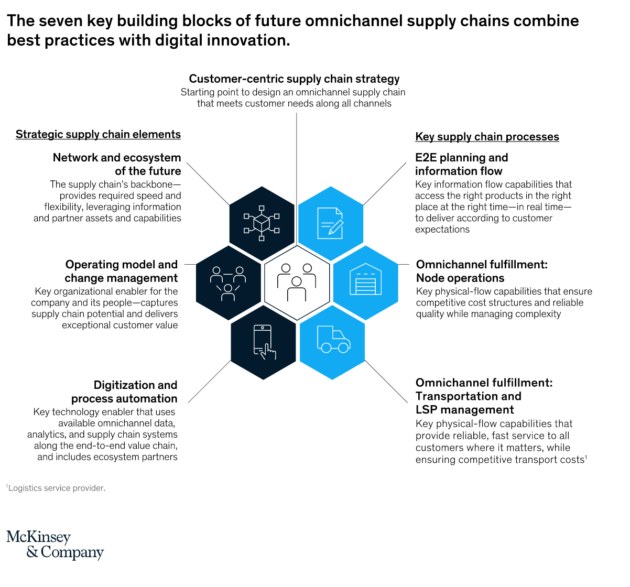
2. Employees
Employees are core stakeholders that the shift towards transparency would most impact. Making their working environments unambiguous and their everyday tasks clear to external audiences allows employees, customers and investors to hold retailers accountable in a public domain.
Welfare: According to Anti-Slavery International, there are 16 million people trapped in forced labour within the supply chains of businesses that supply our goods and services. Supply chain transparency is a small step to providing workers more protection over workplace conditions, wages, and personal agency, helping mitigate the risk of external suppliers taking advantage of labour in the sector.
As a result, by enhancing supply chain transparency, businesses are able to track the social impact of their operations and shine a light on grey areas within their own chains that they may not have complete control over.
3. Investors
Last year, Boohoo lost more than 1.5 billion euros in market value after it was uncovered that workers manufacturing their products earned less than minimum wage in poor working conditions. So making it clear that now more than ever, customers aligning their purchases with their values will have a tangible impact on revenue.
Return on Investment: For investors, the intrinsic link between supply chain controversy and loss in market value is a concerning risk. For example, violations in ESG practices were estimated to have erased almost half a trillion dollars’ worth of value from public companies from 2015 to 2019. ESG stands for environment, social and governance. All three domains increasingly feed into an investors decision to back a company beyond financial projections.
So, with investors progressively looking to work with businesses that have a positive impact, transparency is a firm method of proving compliance with every step of the EGS chain that can easily be mapped to the supply chain.
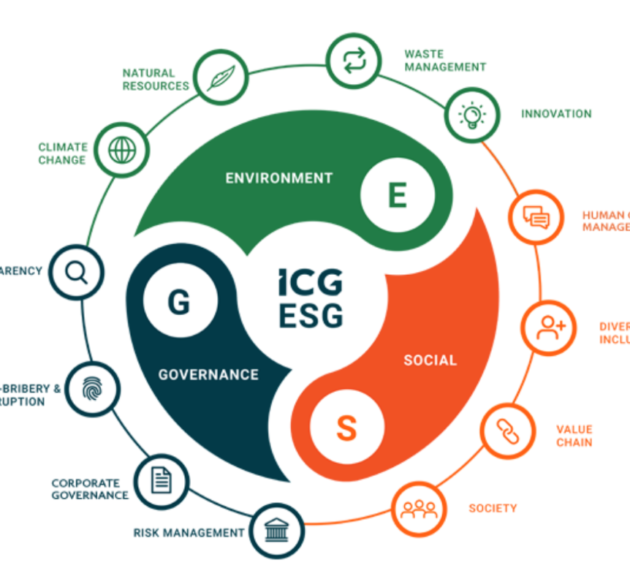
Transparency and Visibility: One Cannot Exist Without the Other
Now that we have made a case for supply chain transparency, there is still the question of how these typically tangled and murky operations can become crystal clear when only 13% of retail executives currently describe having end-to-end visibility.
Although often and mistakenly interchanged for one another, transparency and visibility are two separate concepts when it comes to supply chains, but for retailers, one cannot exist without the other. Therefore, if retailers are to make their supply chains more transparent, they must first be made more visible.
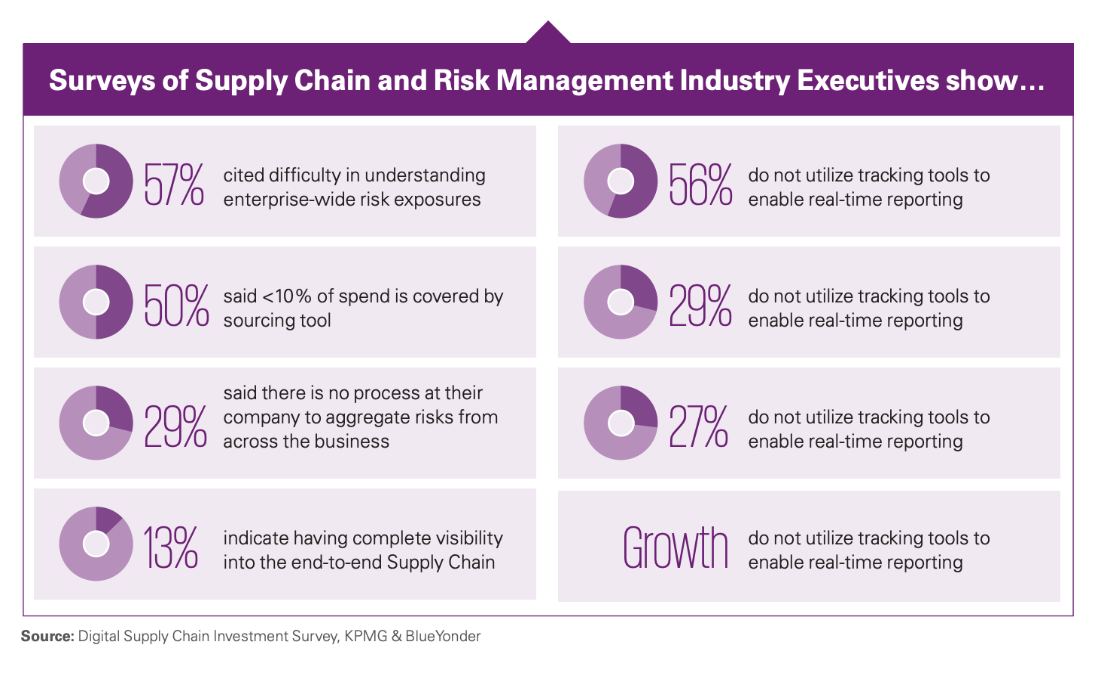
Implementing RFID technology can help provide retailers with unparalleled inventory tracking. By tracing stock at item-level from the factory to warehouse to shop floor, RFID can help retailers improve sustainable and ethical practices within their operations in the following ways:
Post-Purchase Care: By recording raw materials, RFID can assist retailers in tracking the origins of their products and enables them to have a longer life by tracing their composition and helping owners care for their items better.
Carbon Footprint Tracking: RFID technology can follow inventory at item-level at every step of their journey, allowing businesses to calculate the environmental impact of every individual product and correctly offset it.
Workload Easing: RFID also helps retailers ease the strain of workload within factories and distribution centres by taking the place of manual tasks such as stocktake and locating lost items.
Excess Inventory: Limiting the risk of waste products, RFID can help retailers monitor stock and manage future orders with these insights by distributing inventory to locations with high demand or designing a new collection whilst avoiding the features of underperforming products.
Manufacturing Conditions and Compliance: Tracking products back to their production source allows stakeholders to hold retailers accountable if the working conditions and practices of their internal and external factories are below standards.
Implementing Radical Change
Although organisational resistance to change is weakening, according to a recent survey by Accenture, 94% of experts said there is still no obvious effort to align the organisation’s culture with the goals of the change they intended to create. Yet the fact is, supply chains need to become radically more transparent, whether retail wants to embrace it or not.
The pandemic has exemplified change as an uncomfortable yet vital feature of business survival, and technology has been the great enabler for catalysing operational honesty and transparent reporting. But there is still much more to be done. End-to-end transparency is still a rarity, and retailers will need to push forward to experience the benefits of stakeholder satisfaction.
Book a consultation with Detego today to discover how RFID can help your organisation implement lasting and radical change through increased visibility.
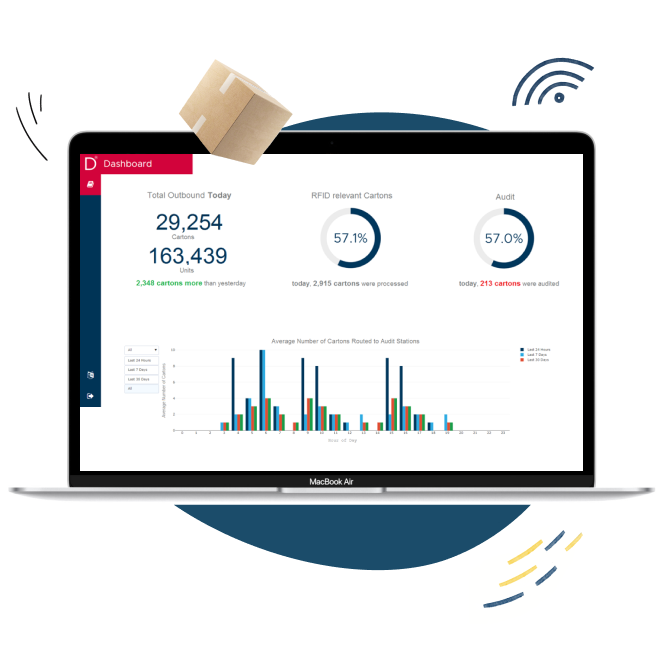
Cloud-hosted RFID software
The digital supply chain
Detego’s RFID-based warehouse software enables retailers to automate and dramatically improve their receiving, picking/packing and shipping processes in factories and/or distribution centres. These steps are vital parts of an end-to-end RFID solution, providing full visibility across the entire supply chain.



